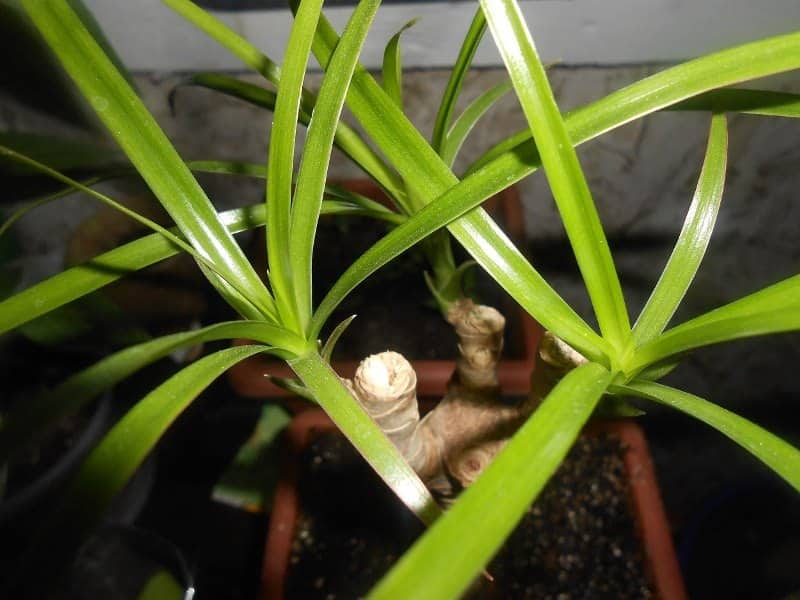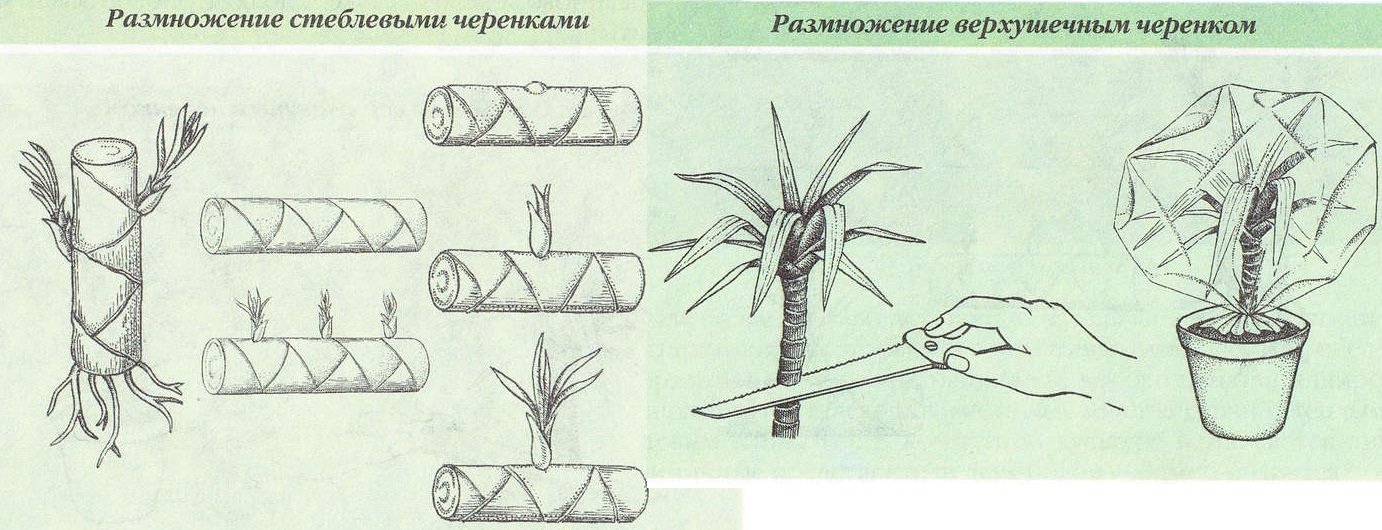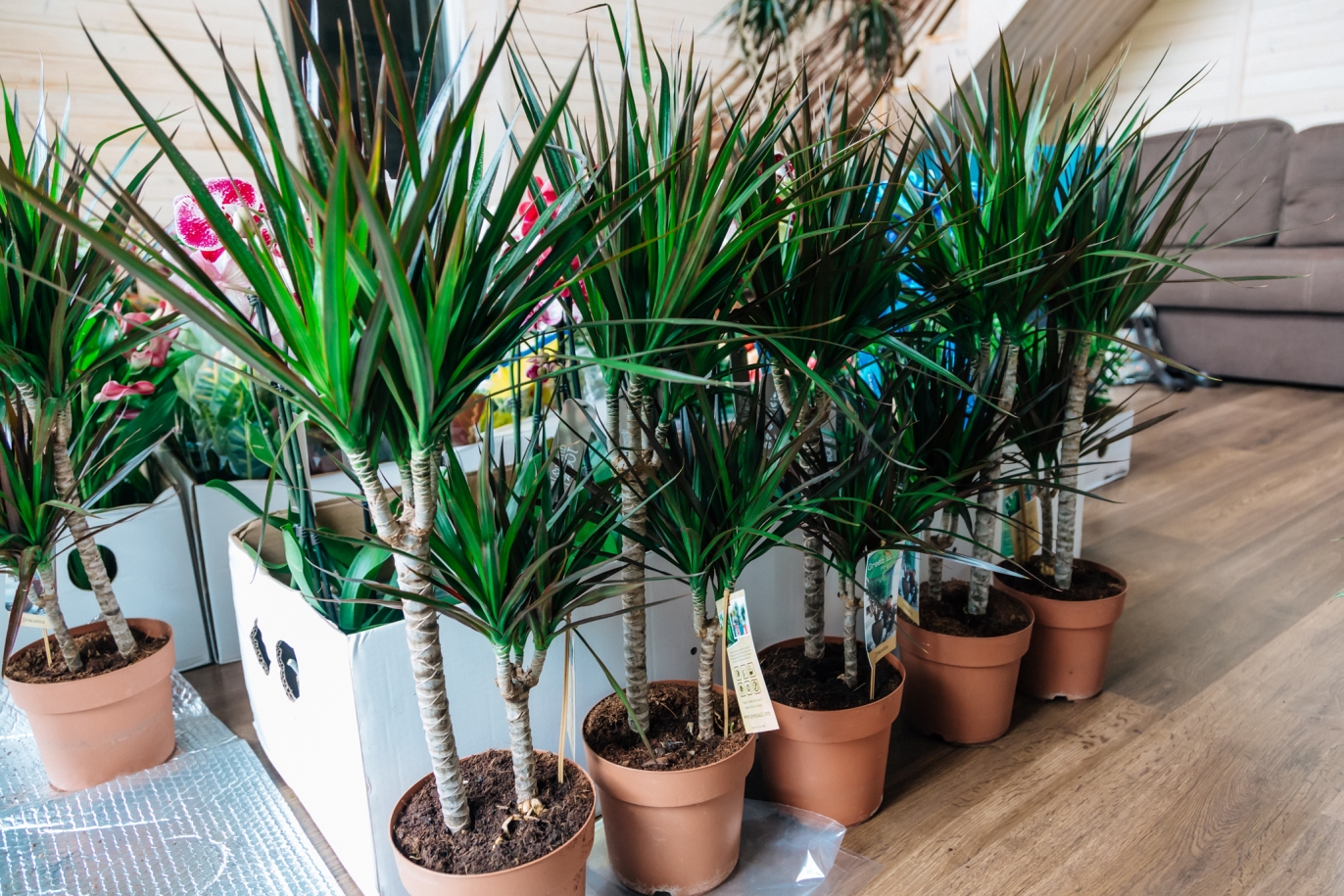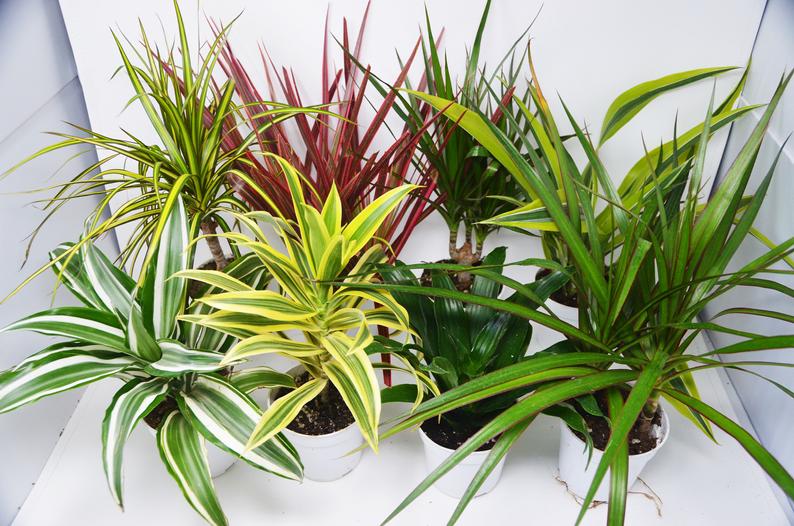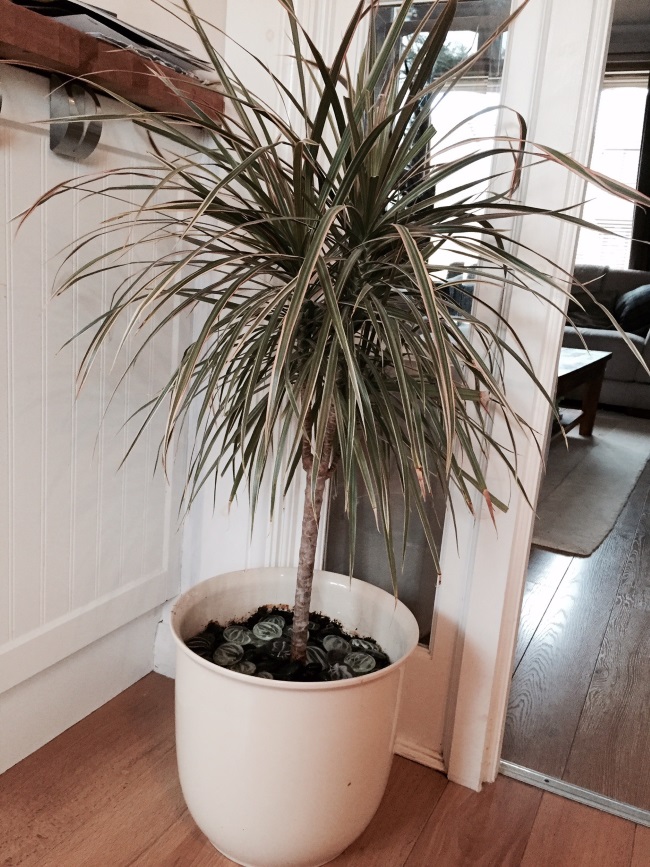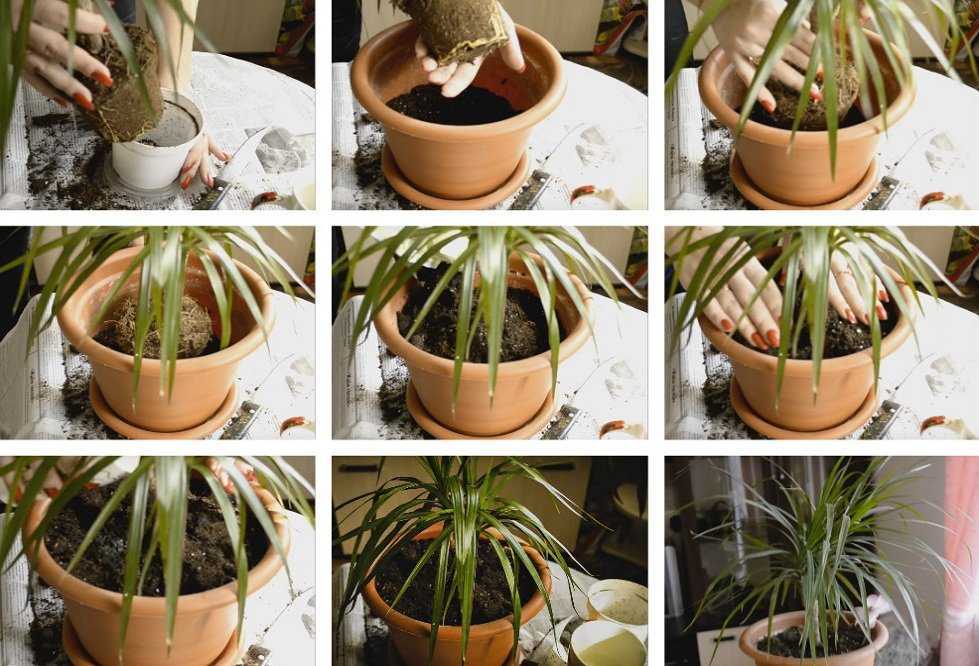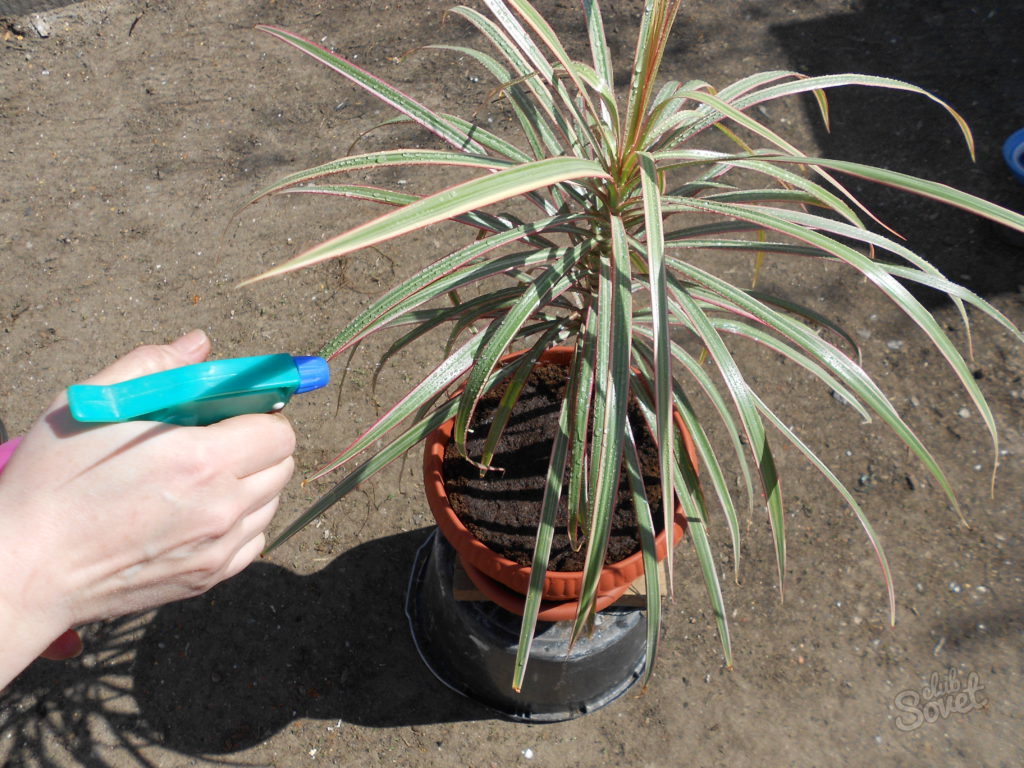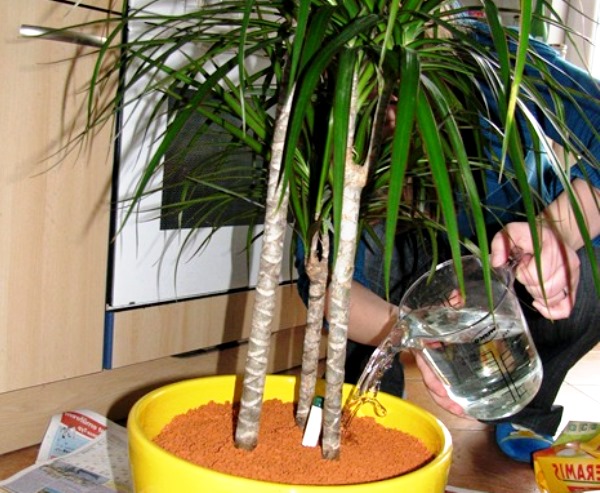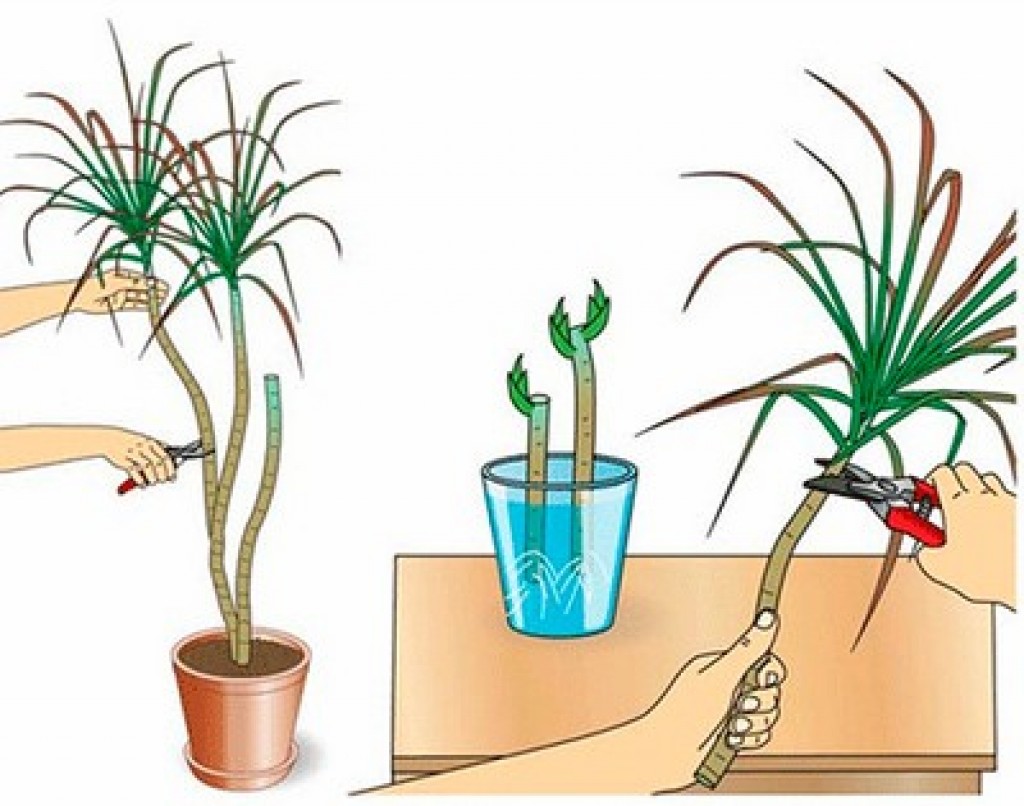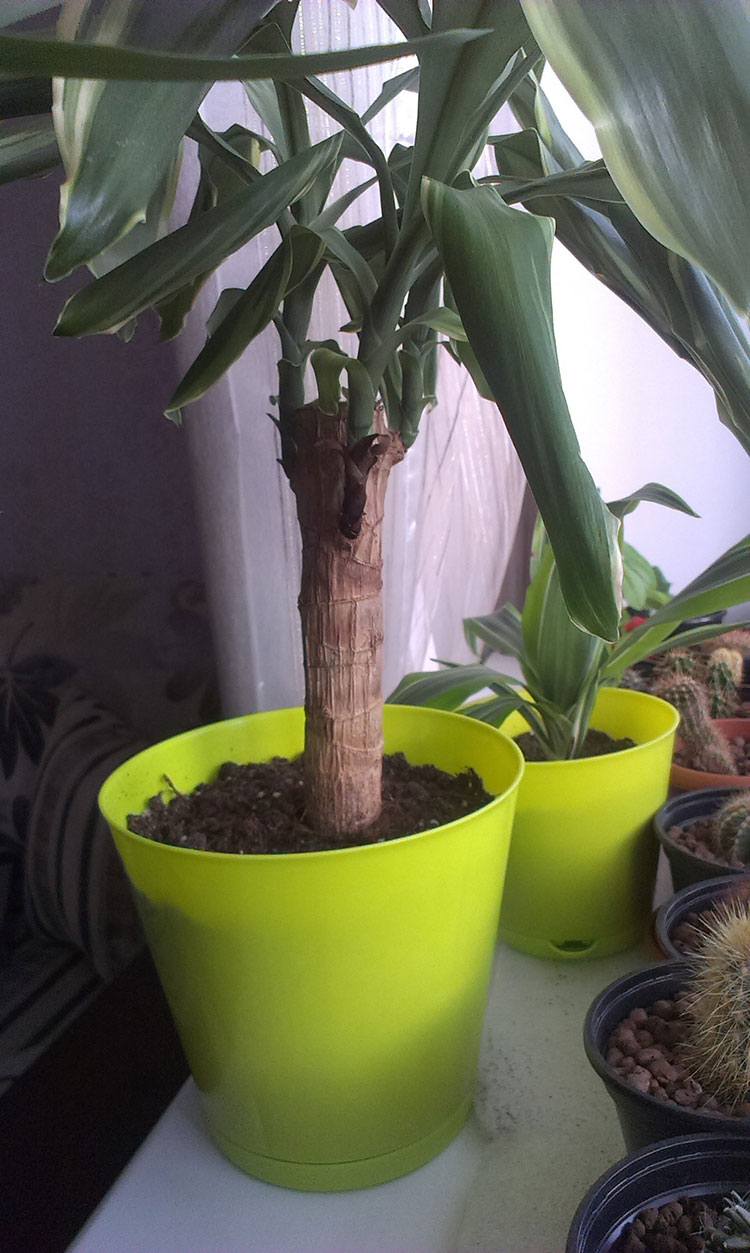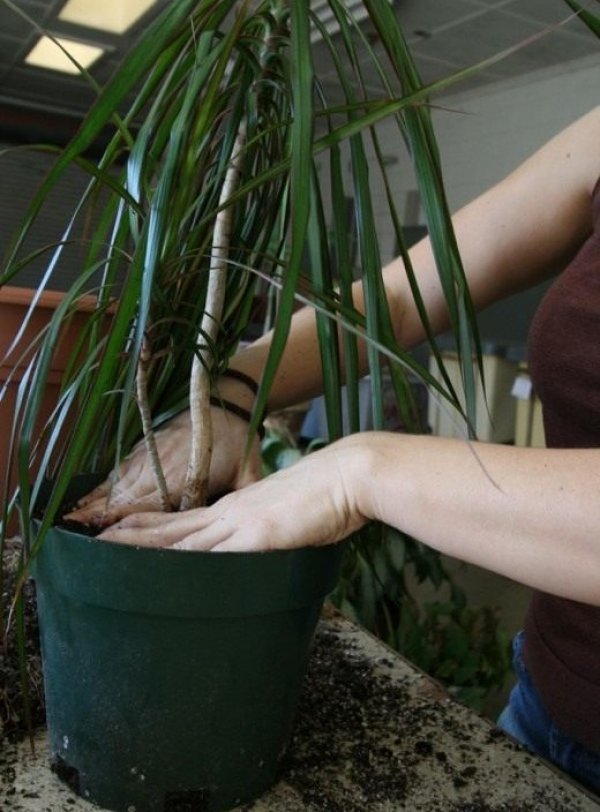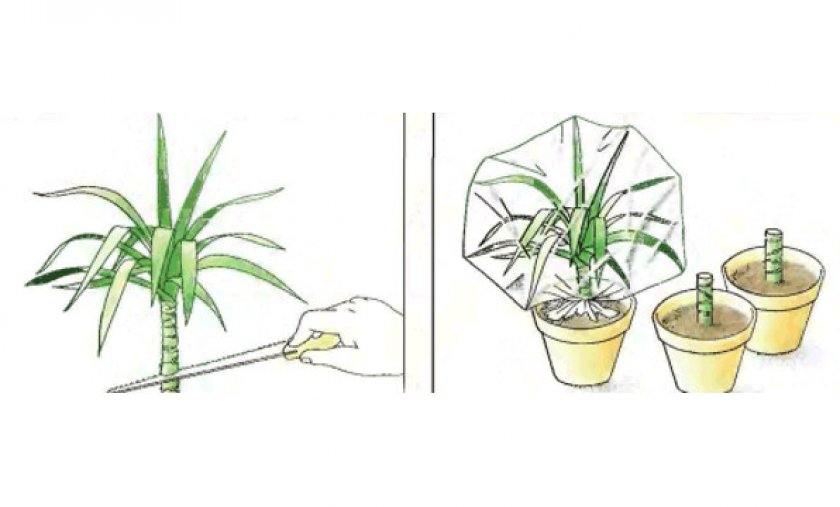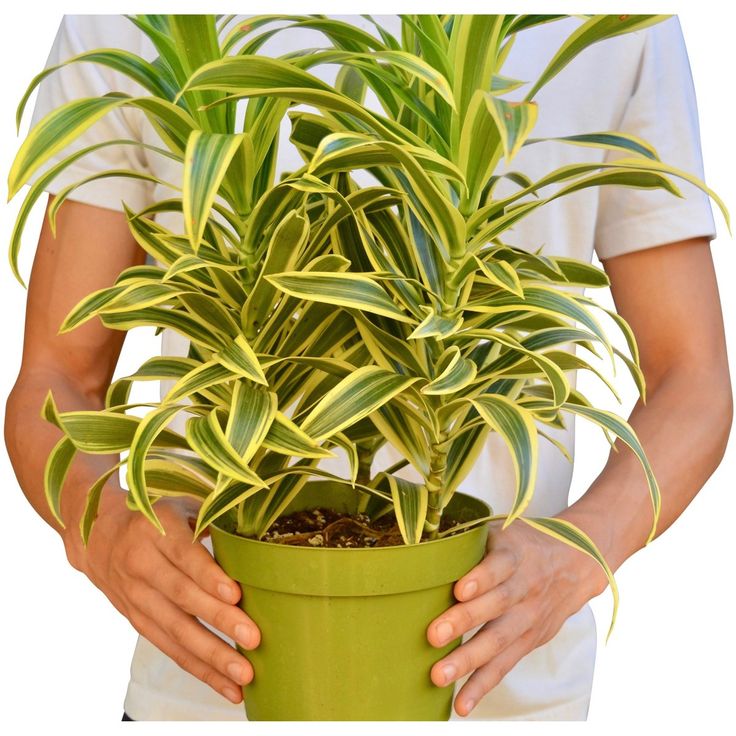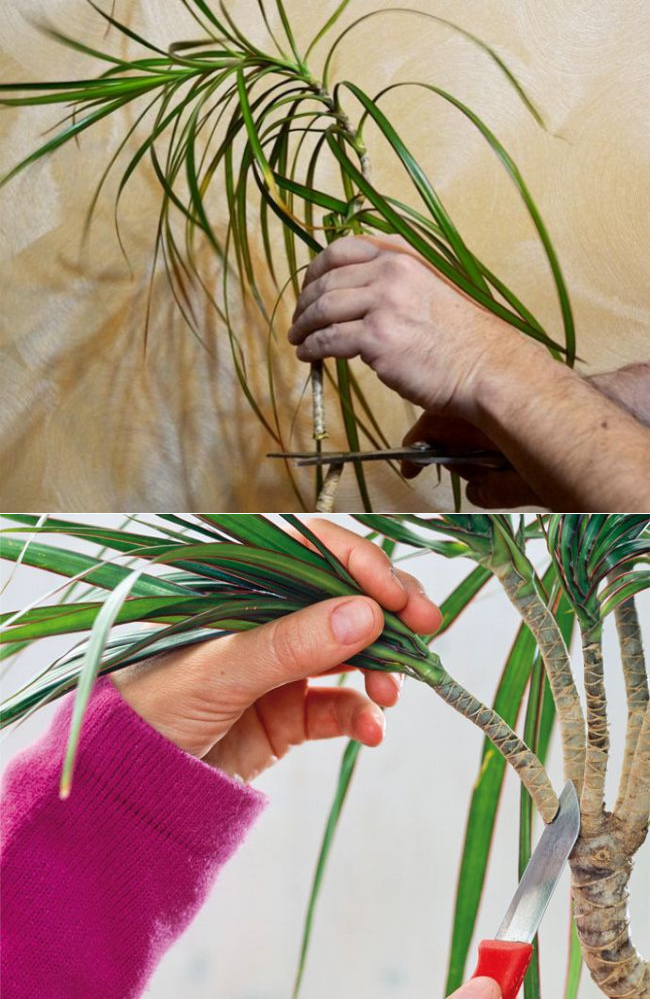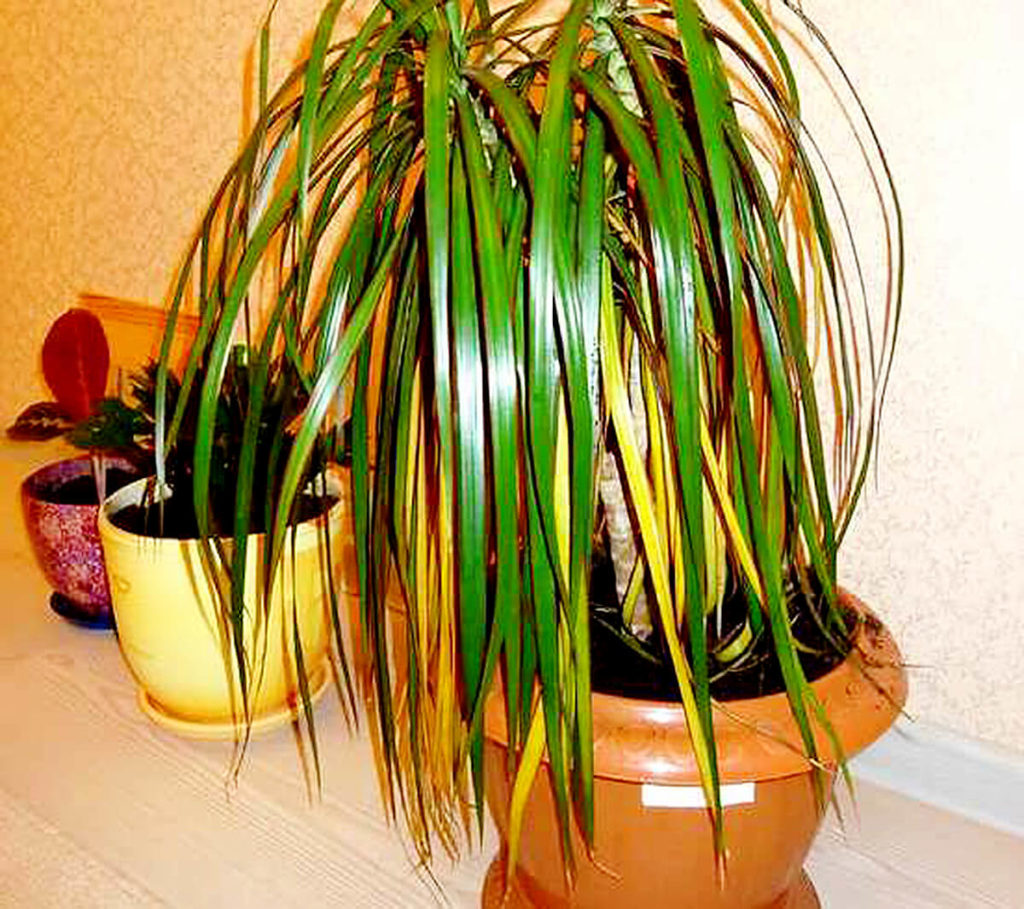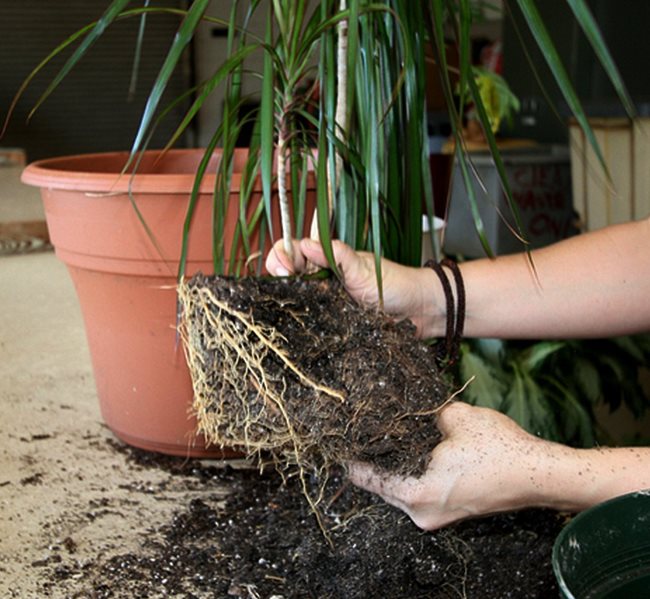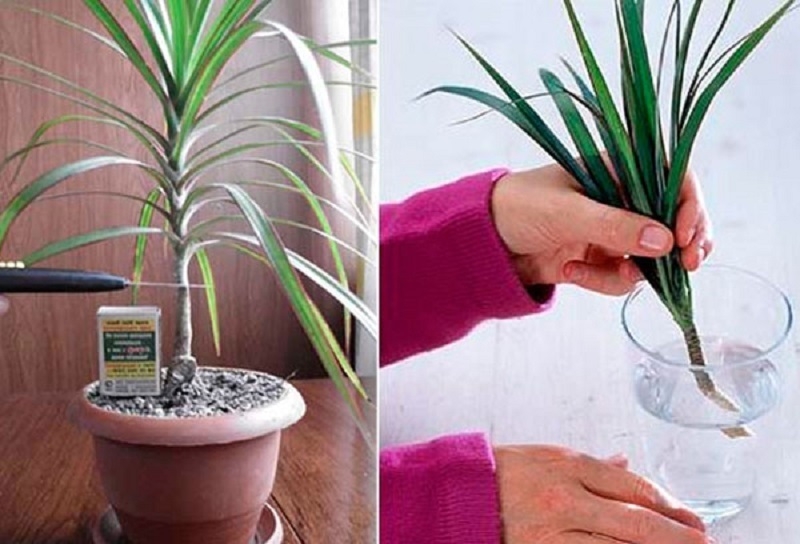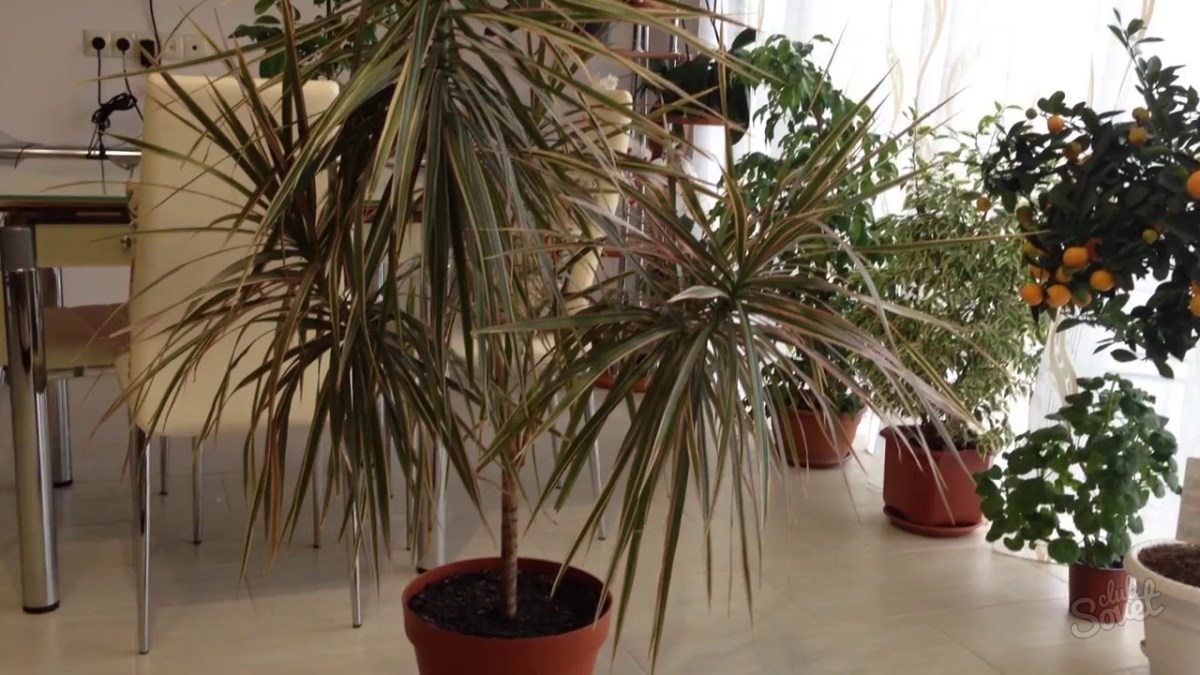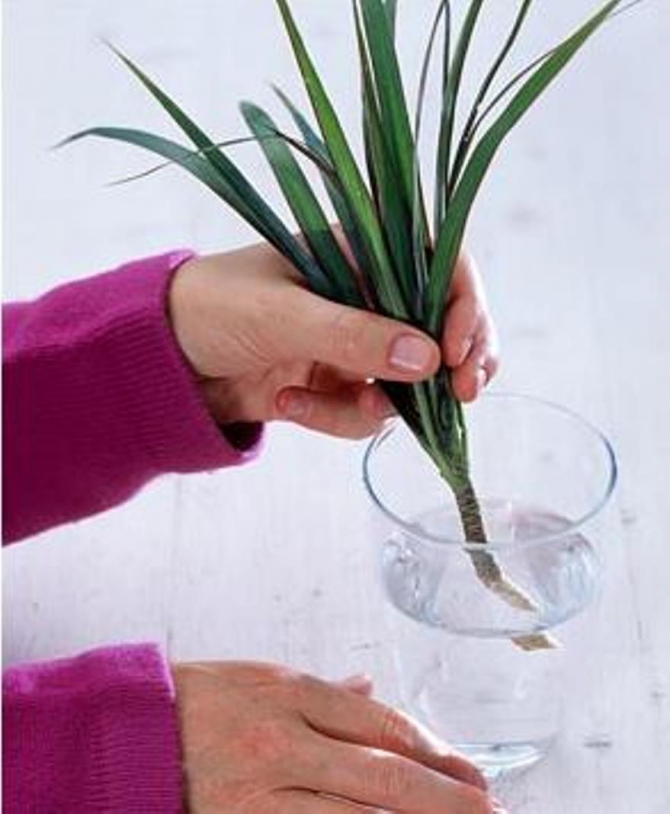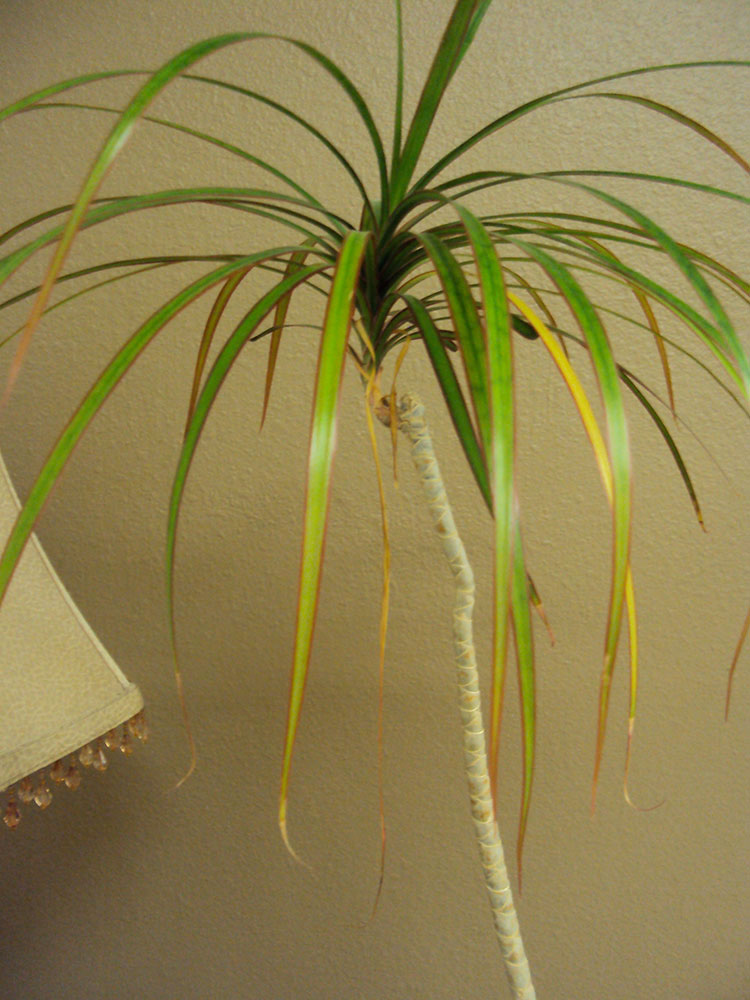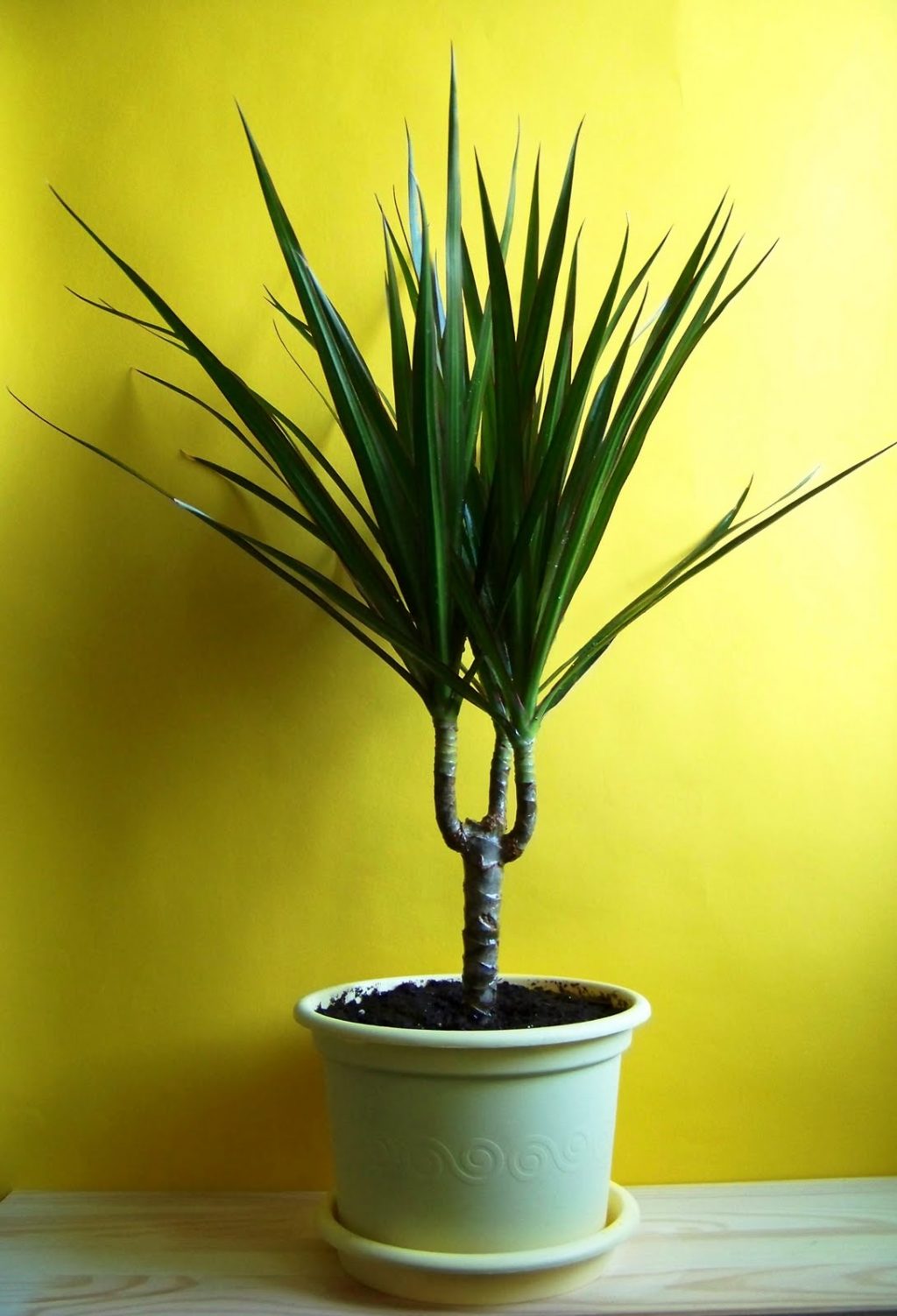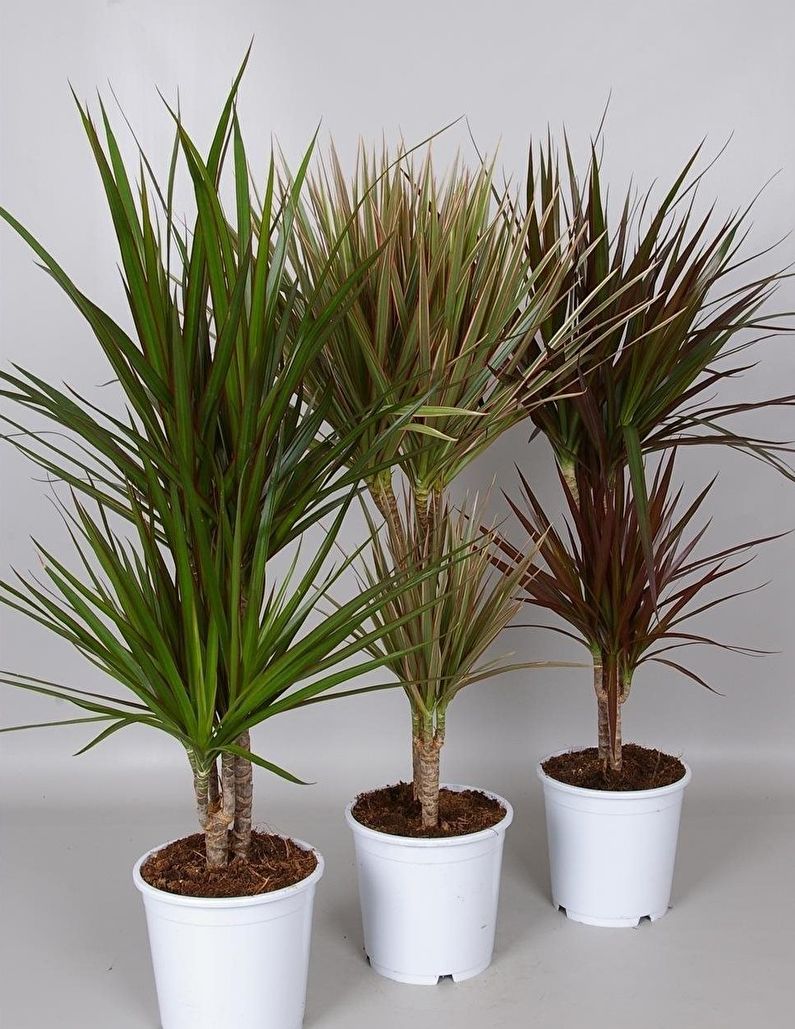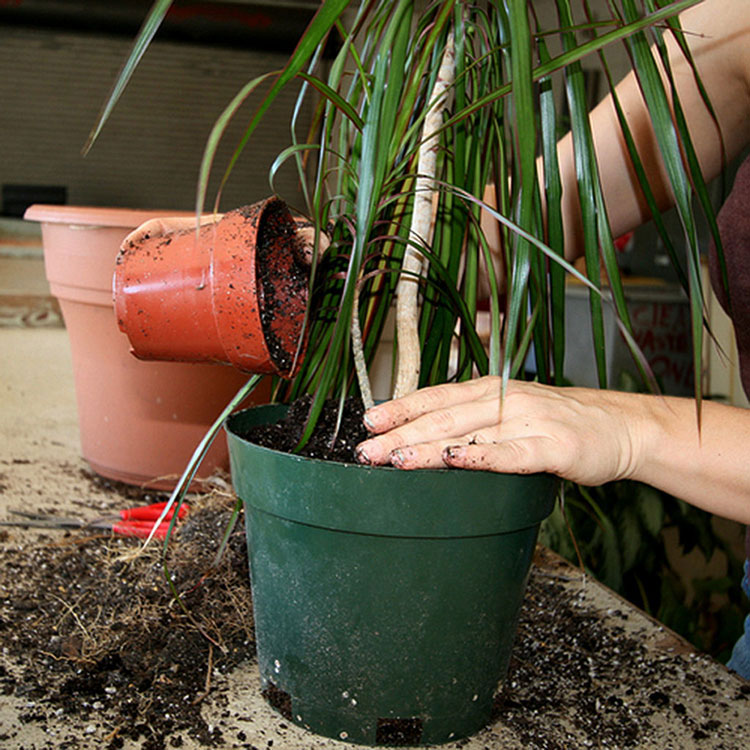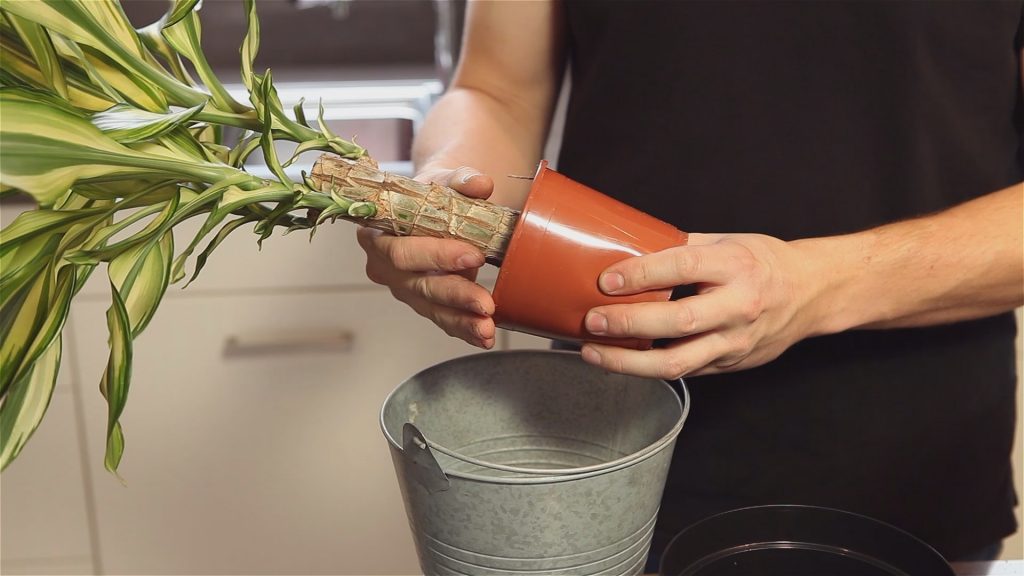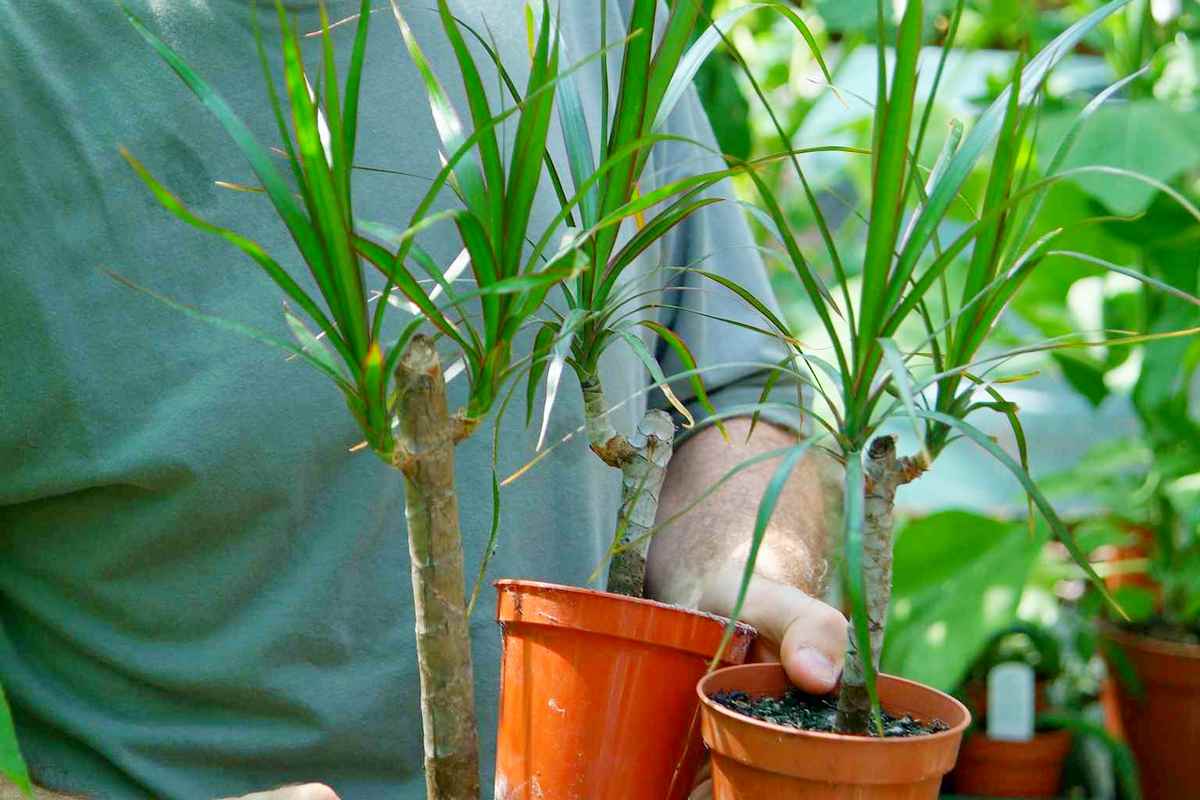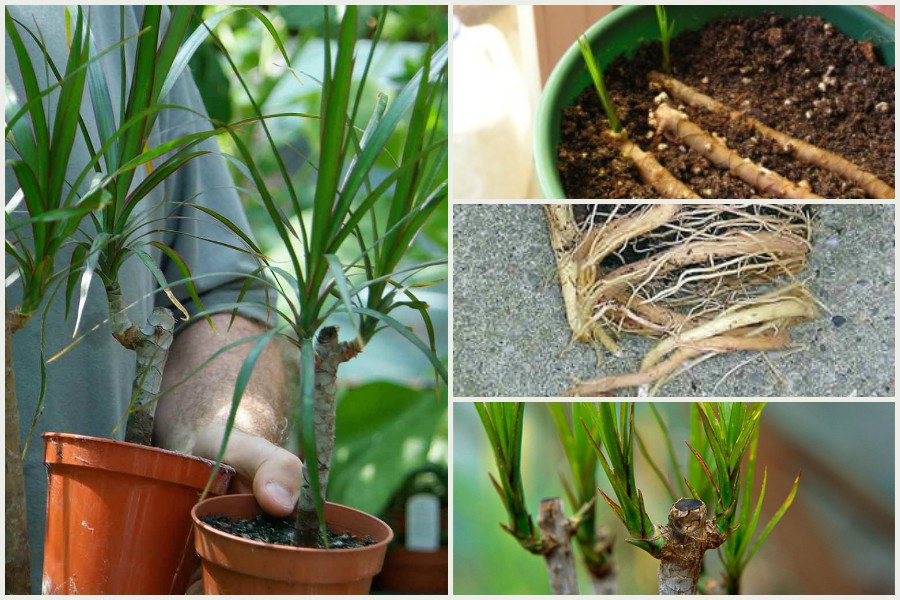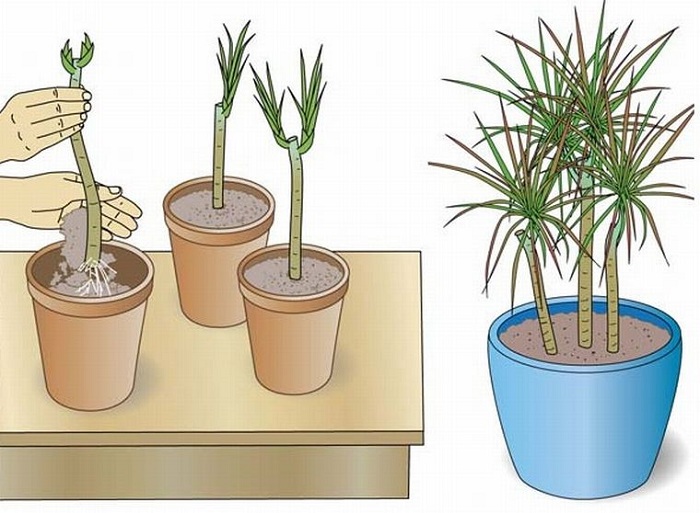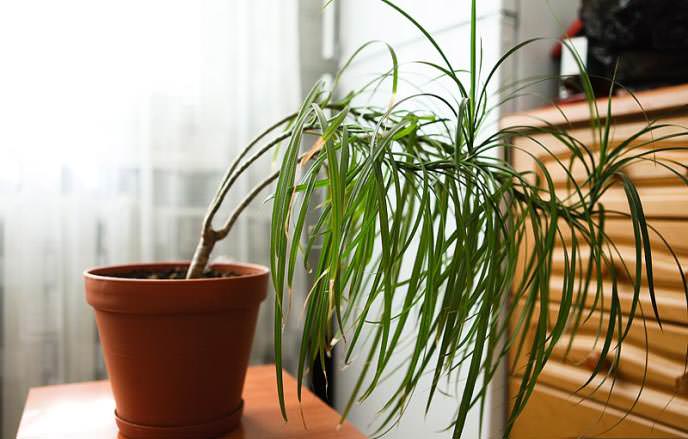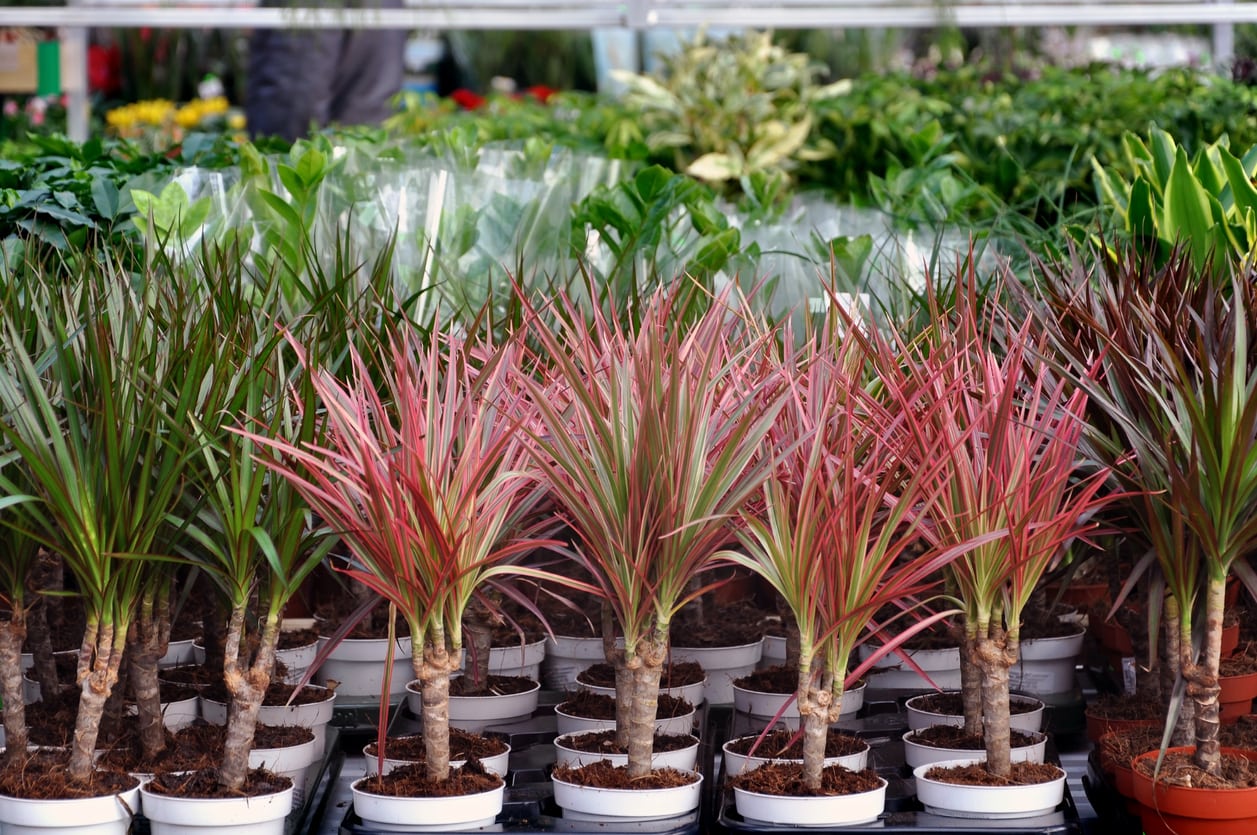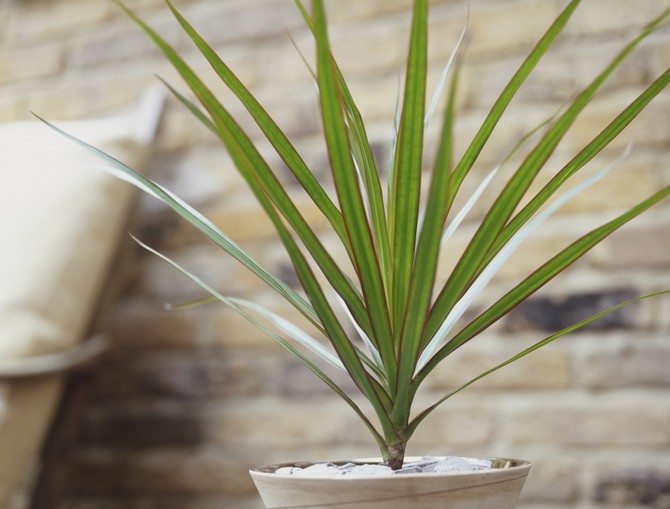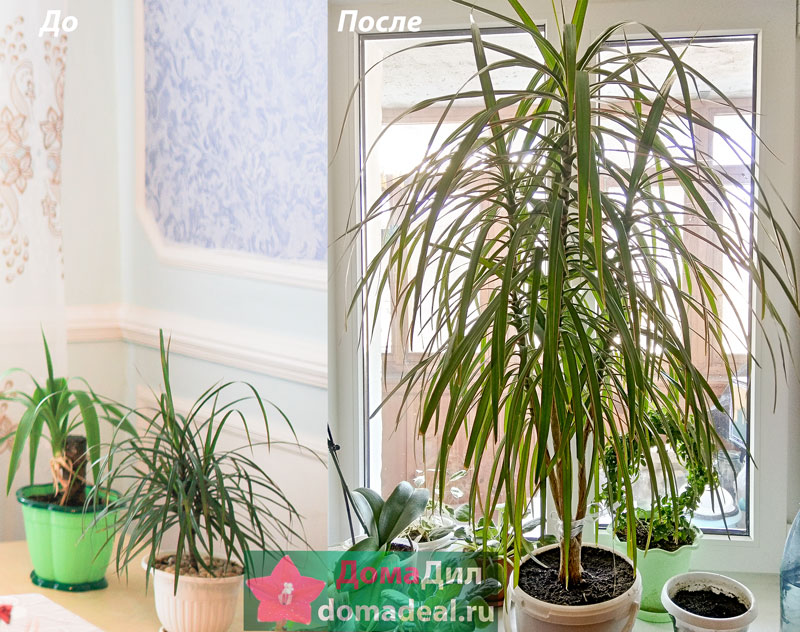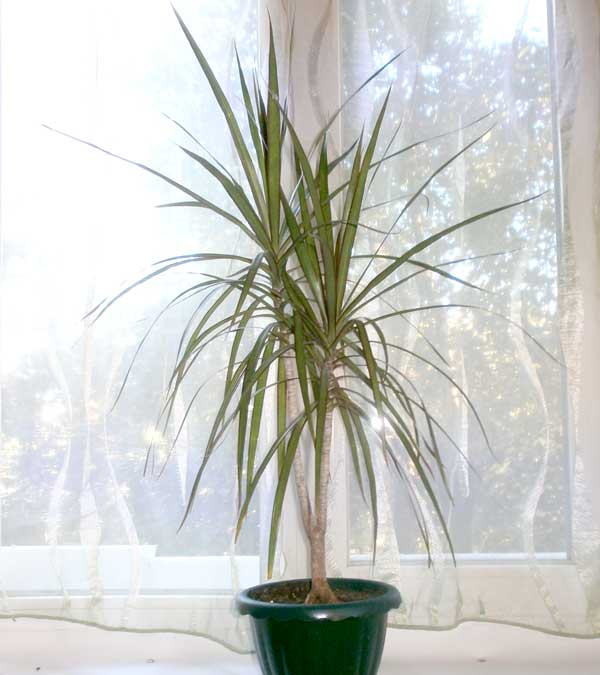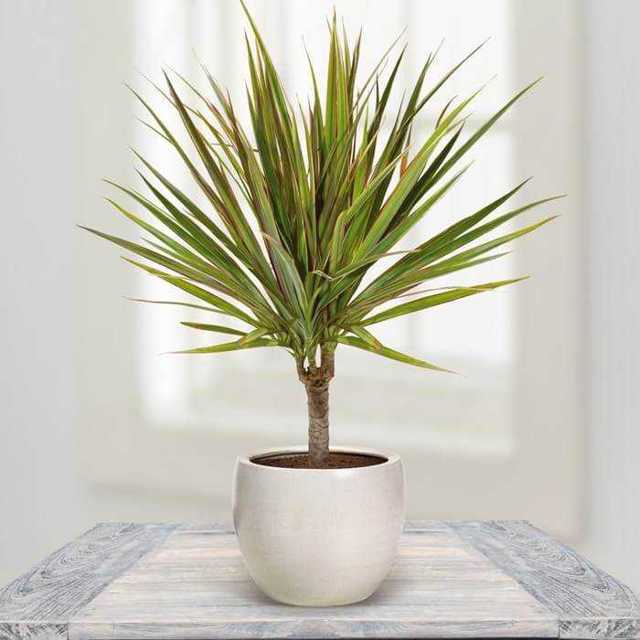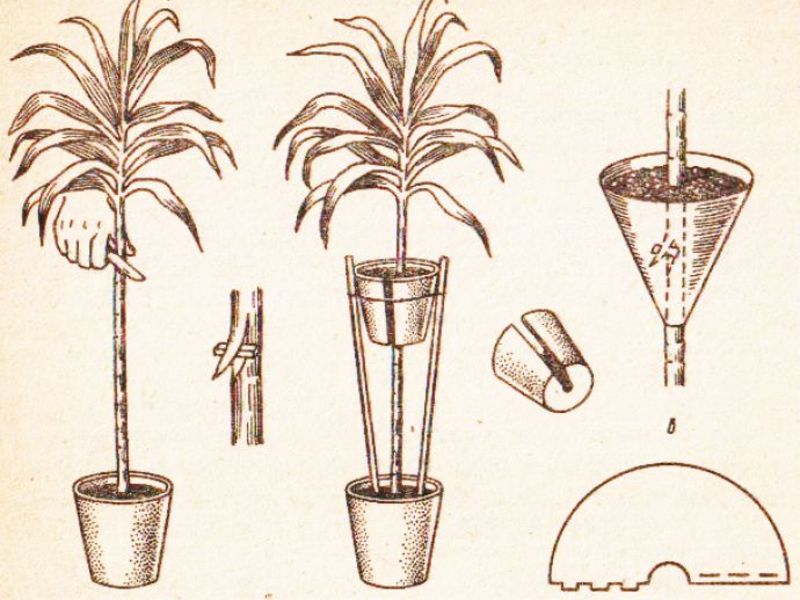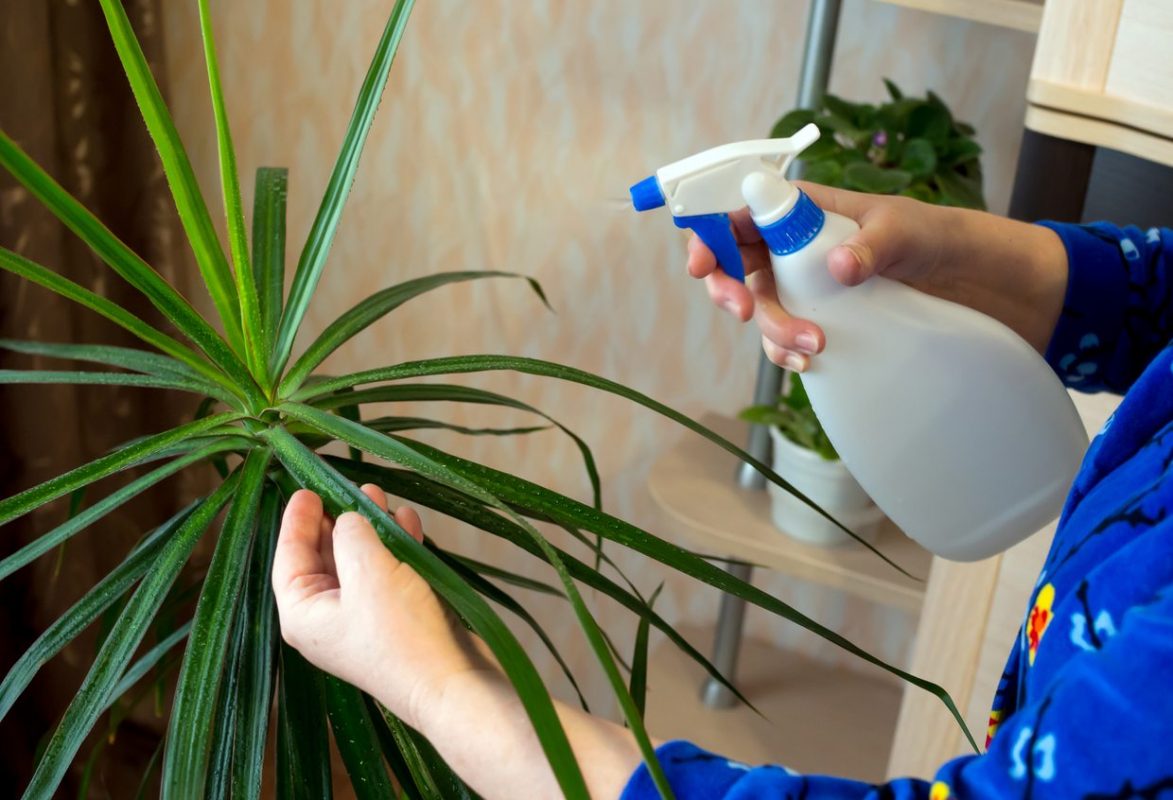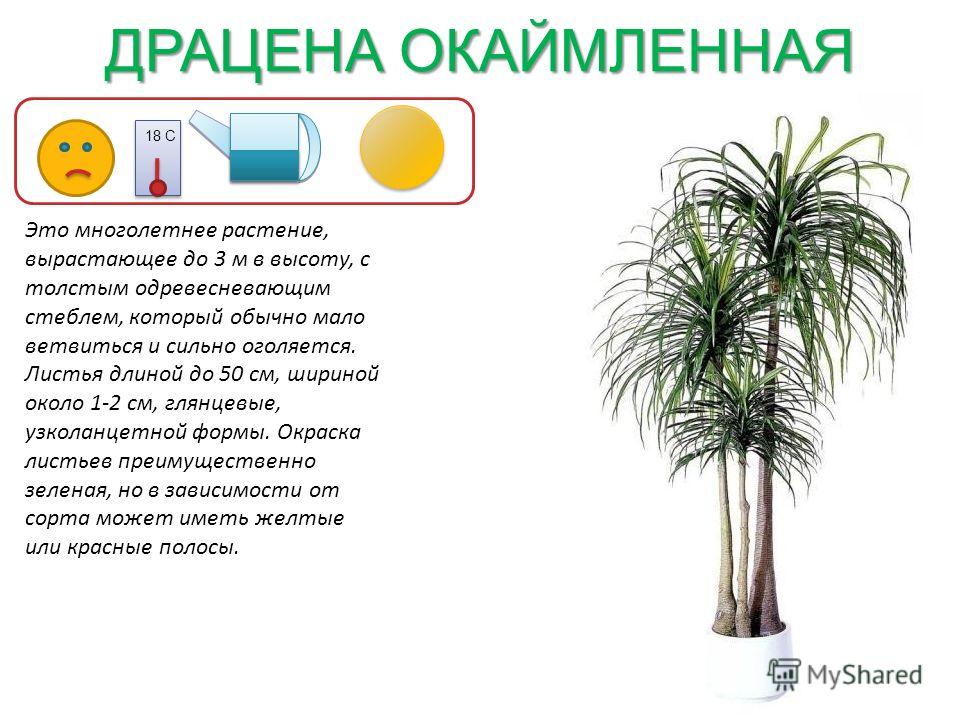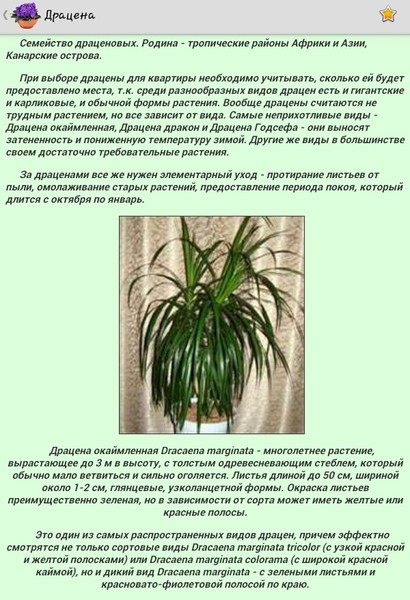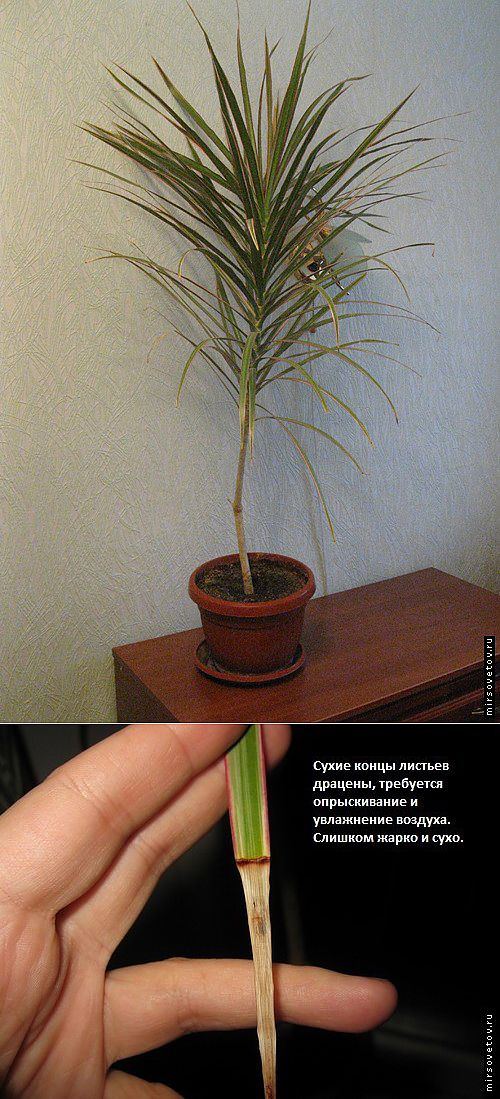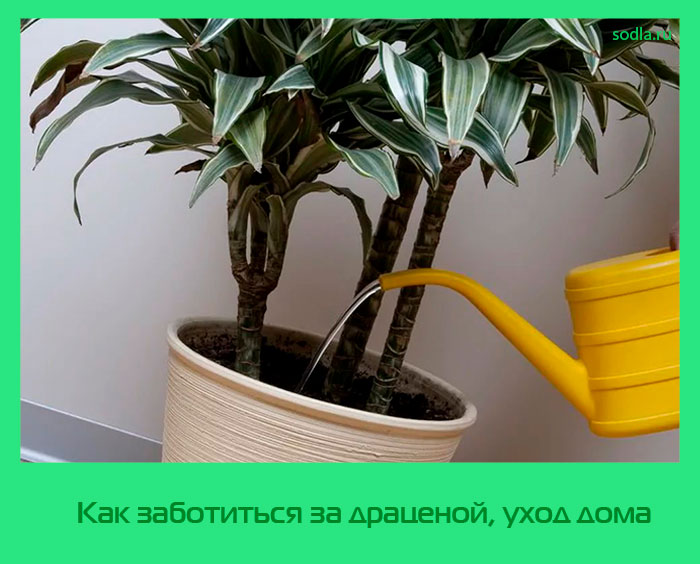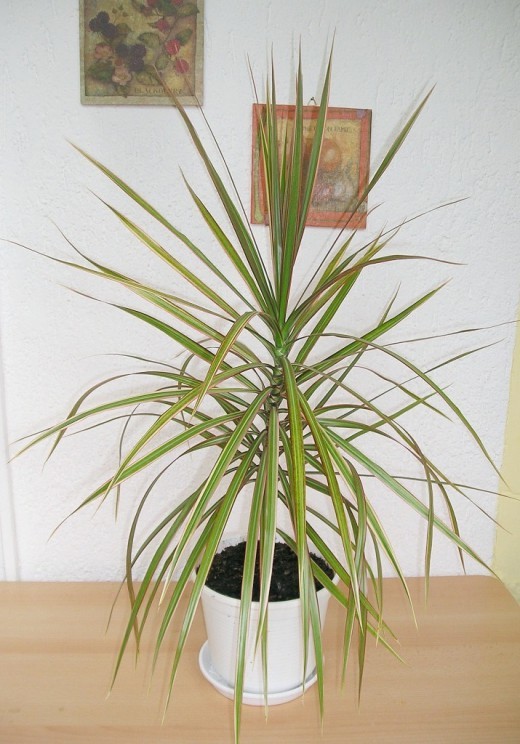Reproduction of Dracaena by cuttings at home
Propagating Dracaena using cuttings is an easy process. It is necessary to very carefully cut off part of the top, while the cut must be even or obliquely cut. The main thing is that the cut is smooth, otherwise the flower will rot. Gardening tools must be sharp and clean.
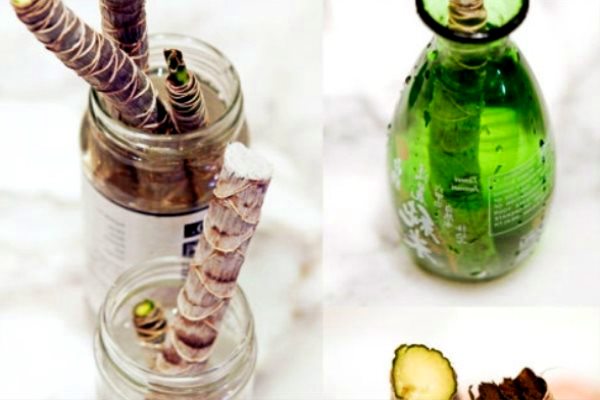
You can put the slice in water for rooting. The water needs to be changed regularly to prevent cloudiness, usually two tablets of activated carbon are thrown into the water.
If desired, the cut can be immediately planted in a small pot. Before planting, let the cut dry a little, then process it with eco-gel. Special soil for planting is bought for palms or cacti. After planting, it is advisable to create greenhouse conditions for the cutting, which promotes the growth of the cutting, facilitates and accelerates the rooting process. Cover the stalk with plastic or plastic sheeting to create a greenhouse. Thus, heat and sufficient moisture will be retained under the film or plastic, the main thing is not to forget to spray the planted stalk twice a day and it will grow very quickly.
Dracaena care at home
Lighting
For these house flowers, which look like a palm tree, it is quite acceptable to be placed in partial shade, but it is recommended to place them in brightly lit areas of the room, but without direct sunlight.
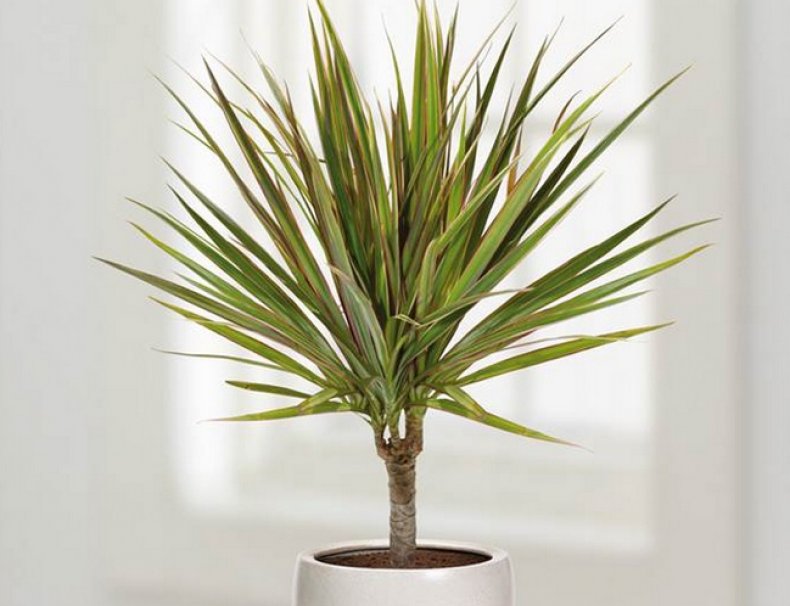
Varieties with variegated colored foliage require more light than plants with green leaves. Lack of lighting negatively affects the growth of dracaena.
The most correct for growing are the east or west sides, which face the windows.
Air temperature and humidity
Although dracaena comes from warm regions, this plant does not like heat, dry air. The plant will fully develop in summer at a temperature of 20-25 ° С, and in winter - at 15-18 ° С. It is also necessary to maintain the humidity of the air by placing a container of water next to it or spraying the dracaena once a week.
Did you know? The plant benefits in various industries: brushes, juice are made from dracaena and horsehair fibers, and resin is used for treatment. The plant itself has a positive effect on the nervous system, bringing peace and good mood.
How to properly water dracaena
In order for the plant to please with its healthy appearance and lush greenery, it must be properly watered. Watering frequency depends on the variety, but there are general guidelines.

Watering rules in summer
Dracaena grows mainly in summer, so you need to water it in large quantities during this period. However, there is the following nuance - watering should be done after the topsoil dries up by 2-3 cm. This usually happens on the 8-10th day after the previous watering.
How to water dracaena in winter
Already in the fall, the soil dries up much more slowly, the dracaena rests during this period and until the end of the winter cold. Accordingly, watering is needed less frequently. Its frequency is once a month. You need to focus on the drying out of the soil, because the plant can stand near the heater, which means that watering will be needed more often.
It should be remembered that your home palm flower does not tolerate frequent watering, since they lead to stagnant water and root rot, so do not make such a mistake in leaving.
Top dressing and soil care
There are special complex dressings that are designed specifically for indoor plants and are sold in stores. It is preferable for the plant to fertilize in liquid form. They should be applied with water for irrigation. At the same time, it is necessary to take into account that it is better to do this during the period of active growth, that is, in the spring-summer time.
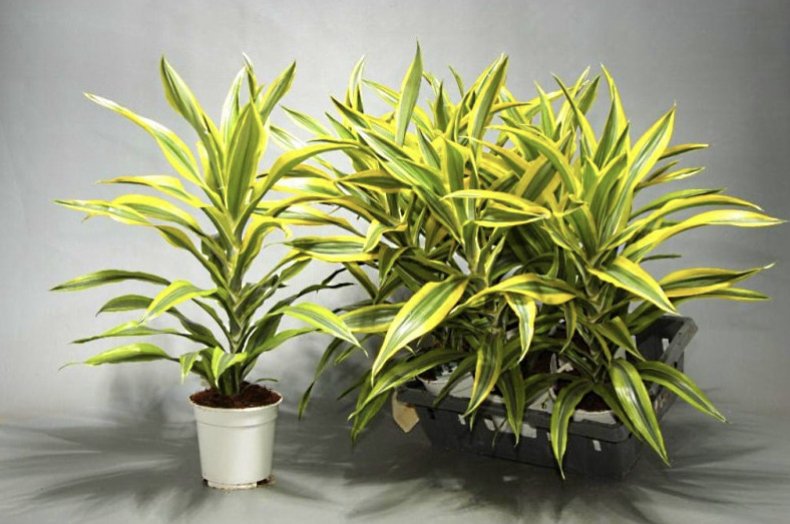
Many lovers of indoor palms, and indeed flowers in general, are interested in their growth, so they want to provide them with suitable care.
An important question is how to fertilize dracaena for rapid growth.
This plant needs the following elements: nitrogen, phosphorus, potassium in a ratio of 3: 1: 3. Therefore, select the right fertilizer based on the presence of these substances in its composition.
Important! In summer, dracaena is fertilized once a week, and in winter, when the plant is resting, it is better not to do this more often than once a month.
The soil is very important for dracaena: nutritious and slightly acidic is preferred. You can buy ready-made soil in the store, there are special mixtures for this type of deciduous plants. If you decide to prepare the soil yourself, then you need to take an equal number of parts: deciduous soil, sand, humus, turf and peat.
Dracaena pruning rules
Dracaena pruning can be done in cases of preventing the spread of the disease or in order to change the shape of the plant.
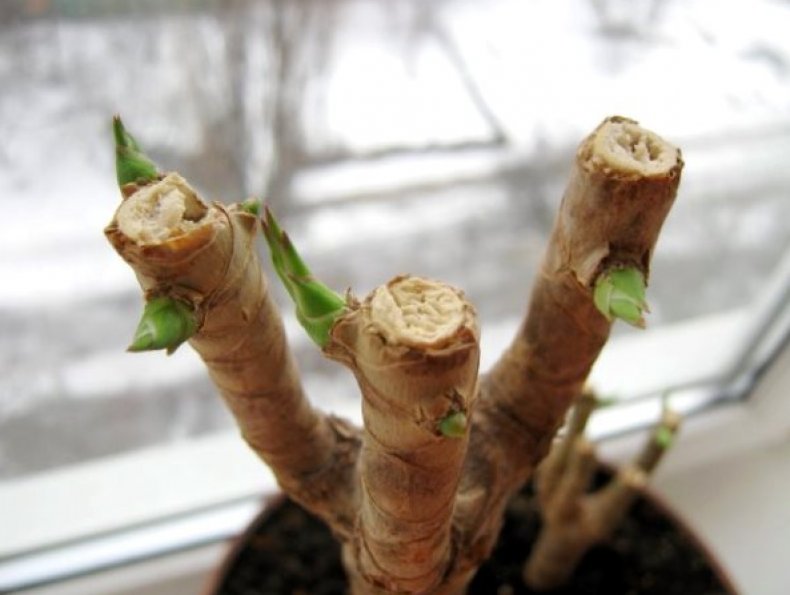
Dracaena should be trimmed during the rest period, that is, in winter. It is imperative to disinfect the pruning tools, and sprinkle the cut points with charcoal or wood ash. You can cut off the top of the main trunk, after which lateral shoots will begin to grow at the dracaena.
Reproduction technology at home
At home, the easiest way is to cut the top of the dracaena during the formative pruning period. After shortening the main stem, the cuttings can be kept in water until the roots appear, and then transplanted or immediately planted in the ground. Seed propagation is a longer and more troublesome process, therefore it is used much less often. Depending on the type of dracaena, the option of reproduction by air layers is possible.
Did you know? The "Explanatory Dictionary" of Vladimir Dahl mentions the original name of this plants - "dragon".
Apical cuttings
Manipulations are carried out in March, when the adult plant emerges from the dormant stage. The cut must be made with a sharp pruner, disinfected in alcohol, at a distance of 15-18 cm from the last leaf perpendicular to the trunk. Next, the stem is cleaned of old foliage and dried for 2-3 hours in the sun.

There are several ways to root a stalk:
- by placing in a solution of "Kornevin" in combination with charcoal;
- having landed in a peat-sand or vermiculite mixture.
Did you know? Dracaena extract is added to hair dye. The rich chemical composition of the juice improves the structure of the hair and prevents damage during dyeing.
The stem with roots remaining after pruning should not be thrown away. The cut point can be treated with Kornevin's solution and, covered with polyethylene, set aside in a dark place where the air temperature is maintained within + 25 ℃. After a week, the container is moved to a well-lit room (but not in direct sunlight) and standard care is provided. After a month, 2-3 lateral shoots will appear at the cut site.
Stem cuttings
If, after shortening the main stem, it is still too high, or rotting of the upper part has begun with a healthy root system, use the technology of propagation by stem cuttings. To do this, the stem must be shortened to the required height, and the resulting fragment must be cut into cuttings 10-15 cm long.

The rooting process is carried out similarly to the above. It takes 1–1.5 months for rooting, and 2–2.5 months for the emergence of apical shoots.
Air layering
In the absence of the possibility of cuttings - for example, when the plants are still low for pruning - they practice the method of propagation by air layers. To do this, you can carry out the following manipulations:
- At a distance of 2 cm from the first sheet, make a perpendicular cut to the middle of the trunk.
- Insert a toothpick into it.
- Wrap the cut with sphagnum moss and wrap with polyethylene.
- Periodically, the moss needs to be moistened with a spray bottle.
- When roots break through the moss, remove the plastic and cut off the sprout.
- Root the cuttings in the soil for adult plants, including a sod-leaf mixture, peat and sand in equal amounts.

Read more about how to properly trim dracaena at home.
Seeds
At home, dracaena flowering followed by fruiting is a rarity. But if the planting material was still received, then you should not hesitate with its embedding in the soil:
- The seeds must be peeled and placed in the Kornevin solution for 20 minutes.
- Then the planting material is dried and laid out on the surface of the sand and peat soil mixture at a distance of 5–7 cm.
- After sprinkling the seeds with dry sand, the containers are covered with polyethylene and placed in a well-lit room, where the air temperature does not drop below + 27 ℃.
- During the germination period, the planting is aired daily.
- When the sprouts reach a height of 5–7 cm, a pick is made into separate containers.

The soil
Dracaena thrives in rich soil with a lot of organic matter, such as peaty commercial potting soil. Water the plant thoroughly once a week, allowing the water to pass completely through the container. There are basic requirements for what kind of soil should be for dracaena:
- Use a potting compound that drains well but retains moisture with a loamy or peaty content. Avoid mixtures with a high perlite content.
- Position the dracaena in bright indirect light for compact growth and good leaf color.
- Water when the topsoil is dry to the touch. Water it thoroughly so the water comes out of the drain holes. Do not use cold water. Empty the saucer under the pot after each watering.
- Use a thermometer to determine the best location for the correct temperature conditions.
- Use a soil pH kit or pH meter to monitor soil pH. Maintain soil pH between 6.0 and 6.5 to avoid fluoride damage in the water. Increase the pH by placing 1 teaspoon of hydrated lime in 1 gallon of water, which raises the pH by about half a unit. Lower the pH by adding about 1/2 teaspoon of granular sulfur to a 6-inch pot and pour over it. Don't let food touch the leaves.
- Fertilize the dracaena regularly when it is actively growing. Apply a balanced fertilizer such as 12-12-12 monthly during the spring and summer at half strength, or 1/3 teaspoon per pot. Spray the fertilizer evenly over the top of the soil and rinse the plant thoroughly.
 Planting dracaena cuttings without roots.
Planting dracaena cuttings without roots.
How to trim
Dracaena can grow to be quite tall, 0.5 to 3 meters tall, if not pruned. When the plants grow out of bounds, simply cut off the tops to the desired height. They will sprout again. You can then root them to have even more plants or pass them on to friends.
How to plant dracaena plants
Choose a container that is no more than a third larger than the plant's root ball. Fill one third of the container with the houseplant mixture. It has a composition designed in such a way that insects do not multiply in it. It has no compost or bark that they can use as hiding place. The mixture is also easy to wet, thanks in part to the coconut coir.
 Dracaena cuttings in water for root development.
Dracaena cuttings in water for root development.
Place the plant in a container and position it so that the top of the plant's root ball is about 3 cm below the top of the container to water the plant without overflowing the pot. Water the plant thoroughly and let it drain, then move to its permanent location.
 The root system of a young plant.
The root system of a young plant.
Transplant features
Dracaena, for which home care does not require much effort, needs a regular transplant, which contributes to its longevity. It is not difficult to determine whether a plant requires transplantation: a 40 cm high dragon tree corresponds to a 15 cm diameter pot. Usually, a dracaena transplant at home is carried out every 2 years. Young plants are replanted annually until they are 3-4 years old.
When doing it, it is necessary to slightly wrinkle the shipping container, then carefully remove the flower from the container without damaging the roots. Remove old soil from roots. Put drainage material at the bottom of the new pot: expanded clay, small pebbles, sprinkle some earth, for example, special soil for palm trees, place the plant, cover it with earth, leaving the root collar open. To speed up the engraftment process, it is watered every 2 weeks with the "Zircon" growth stimulator. The surface of the soil is covered with small pebbles and other decorative material.

Dracaena care at home: why Dracena leaves dry
If there is a problem with the drying of the leaves and a brown tint appears, you need to sound the alarm and look for the reasons. This can be dry air in the room or rare watering of Dracaena.
It is very important to observe the necessary humidity in the room, since due to excessive dryness, the plant can be affected by a spider mite, then the leaves will begin to dry out and turn yellow. If a spider mite is found, you need to spray the flower with water
In case of severe damage, it is necessary to treat it with chemicals that are sold in flower shops.

Sometimes the defeat of Dracaena and dryness of the leaves cause the appearance of thrips - this is a small black insect that can leave gray stains on Dracena, more precisely on its leaves. Also, this insect can cause the slow growth of the flower. If you find such signs, you need to thoroughly rinse the plant with soapy water.
Leaves often fall off and dry as the plant naturally ages, which is a normal process. The Dracaena leaf has a lifespan of two years.
Reproduction
Not everyone knows how to grow dracaena from seeds. So species with green leaves are propagated. Young green-leaved plants were grown from seeds, which are a small bush.
Before sowing, the seeds are soaked for a day in a stimulating solution, then placed in a prepared substrate, covered with a film and kept at a temperature of +30 ° C for 1–1.5 months, opening only for moistening. The sprouts that appear are watered, fed monthly, and when they grow up to 5 cm, they can be planted in pots.

More often the tree of happiness is propagated by cuttings or layering. A young long stem is cut with a sharp disinfected tool into 3–5 cm long pieces, each is slightly cut on one side and placed in soil or a special substrate (sand, vermiculite, peat). Greenhouse conditions are created for the cuttings, and after a month and a half, they take root. New shoots grow from the hemp left after cutting the cuttings. It is advisable to treat the cut site with paraffin to reduce moisture evaporation and prevent infection. The cut off top with leaves can be rooted in water.
To form a layering, the stem is not cut off, but a T-shaped incision is made, a little wet peat is inserted there, and tied with polyethylene. After a month, roots appear there, the layering is cut off and a new plant is planted in the ground.
Conditions for transplanting Dracena in room conditions
Replacing the container requires certain conditions to be met. It is necessary to choose the correct pot for the height of the plant. A 40-centimeter tree needs a planter with a diameter of 20 centimeters. The shape of a glass is possible. With subsequent transplants, the capacity is selected 6-8 centimeters larger than the previous one.

Development can be facilitated by:
- correctly selected soil mixture;
- adherence to hygiene requirements when replacing the container;
- neatness with thin roots;
- ensuring the restoration of the root system after the end of the procedure.
The soil can be made with your own hands, or you can buy ready-made for palm trees. Gardeners prefer ready-made mixtures, since they contain all the necessary trace elements. Whatever mixture you use, it must first undergo a sterilization procedure.
Home cooking is as follows: sod land, peat, leafy soil and compost are combined into a single mixture in a ratio of 2: 1: 2: 1. It is advisable to add crushed birch charcoal or vermiculite substrate. Adding crushed red brick to crumb is encouraged. Expanded clay, broken glass or small pebbles are used as drainage. It is not worth reapplying expanded clay, as it absorbs bad salts.
The material for the manufacture of the pot does not play any role. The main thing is the presence of a drainage layer. The container should be rinsed with hot water and laundry soap.
Required inventory:
- scissors;
- secateurs.
They must be sanitized. You need to water it with settled soft water. All transplanting actions must be carried out with special care so as not to harm the root system. This concerns the compaction of the soil after placing the roots in the container.
If it is necessary to transfer to a larger container, it is worth resorting to transshipment. First you need to dry the lump within two days. This will make it possible to pull the plant out of the pot without damage, after tilting it. Earth is poured into a new container, equipped with a drainage layer, and the removed tree is inserted in the center. Earth is sprinkled on all sides and compacted. Then you should water it thoroughly. For the development of the root system, it is necessary to provide the plant with moderate lighting and a room temperature in the range from +20 to +22 degrees within 15 days.

Transplanting and pruning at home
If the palm tree is never cut off, then its crown will acquire an elongated ugly configuration, it will lose its splendor. In addition, pruning is needed for reproduction.
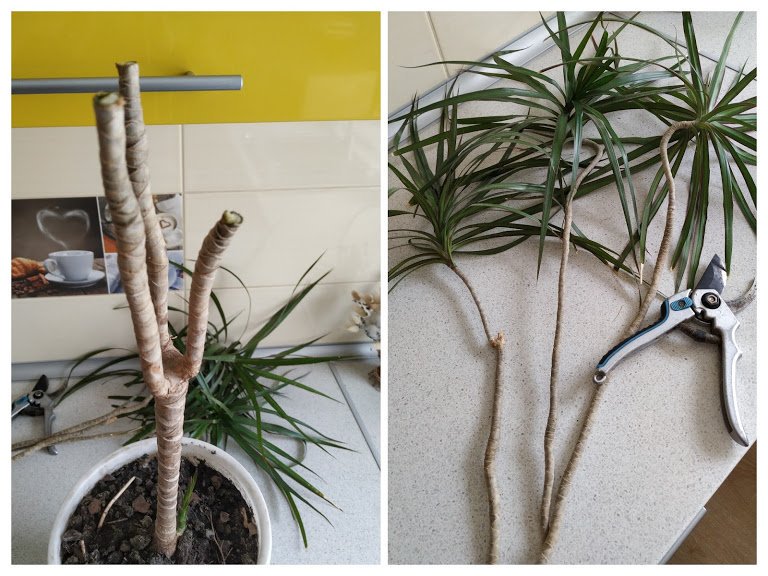
Use one of two cutting methods:
- The trunk is completely cut off at a certain height. The cut is covered with crushed coal or filled with liquid paraffin. In about a month, lateral shoots will begin to grow in this place, forming a new crown. The trimmed part of the stem is rooted in a separate pot.
- Below the top of the stem, a shallow transverse incision is made, which is wrapped with wet moss and polyethylene. When aerial roots appear, the stem is completely cut off and transplanted into a pot.
Now let's figure out how the dracaena transplant goes at home. The procedure is carried out with a strong growth of the root system, in order to replace the soil, when the roots are damaged by pests, as a planned annual event, two weeks after purchase.

The best time to transplant is early spring. The diameter of the new pot should be 2.5-3 cm larger than that of the previous container. First, a drainage layer of broken brick, expanded clay or pieces of foam is laid at the bottom. Since the transplant is carried out by the transshipment method, the palm is not watered for 3-4 days the day before. The flower, together with an earthen lump, is placed in a new pot, and the voids around are covered with earth. For two weeks after transplanting, provide abundant watering and feeding to stimulate root formation.
Reproduction of dracaena
If you want to grow these lovely house flowers that look like a palm tree and are called dracaena on your own, there are many ways you can do it. The most laborious of them is seed.
Seed method
Dracaena seeds are commercially available, so you can grow this plant from scratch. After studying some of the rules, you will learn how to germinate dracaena from seeds.
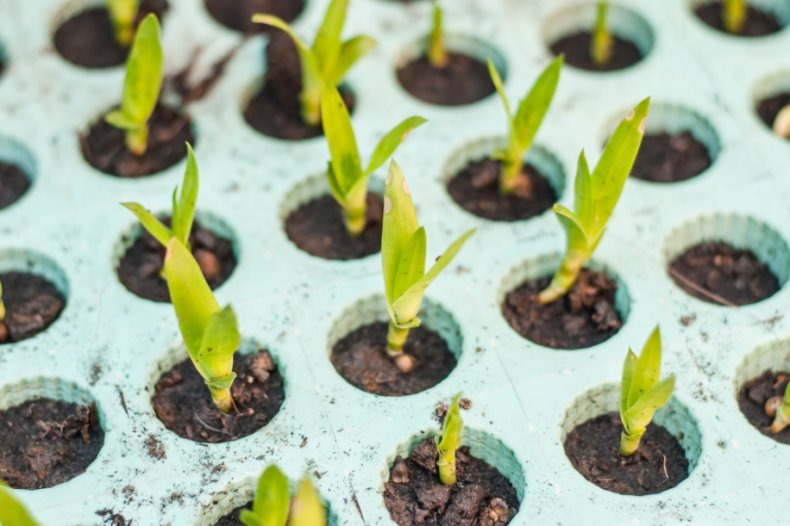
Before sowing, the seeds must be soaked in water at a temperature of 26-30 ° C for about a day. After that, you need to make a depression in the already prepared soil, put seeds there, sprinkle with earth, cover with foil and remove to a warm place.
The lighting must be adequate. It is necessary to water and air the seeds from time to time. The first shoots will appear in about 1.5-2 months, and when the shoots reach a height of 6-7 cm, they can be transplanted into permanent pots.
In general, it will take about 2 years to grow dracaena from seeds.
Dracaena cuttings
For this method, you need to take only strong young stems about 4 cm long. Each such cutting should have 2-4 buds. Cutting off the desired part with a disinfected tool, it is rooted in the prepared soil, watering and ventilation is provided. It is better to make a small greenhouse for the cuttings using a plastic bottle.
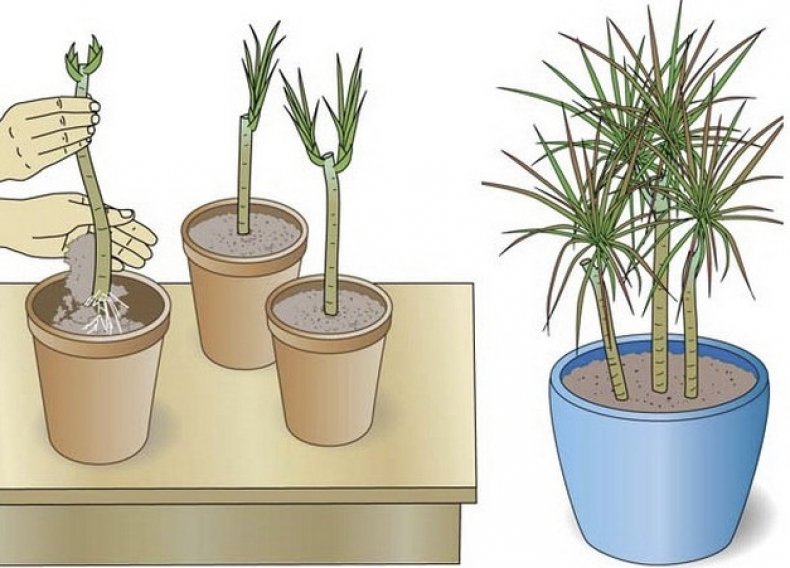
Rooting and emergence of the first shoots occurs within 1-1.5 months.
Important! The plant really does not like excessive watering, so there must be good drainage in its pot.
Reproduction by layering
The easiest way is to reproduce by layering. For those interested in how to grow dracaena using this method, we will tell you that you need the top of the plant here. It must be cut off with a sharp knife: the length of the section from the leaves to the cut should be about 15 cm.
After the layering dries up, you need to put it in a container with warm water, adding activated carbon or wood ash to the water for disinfection.
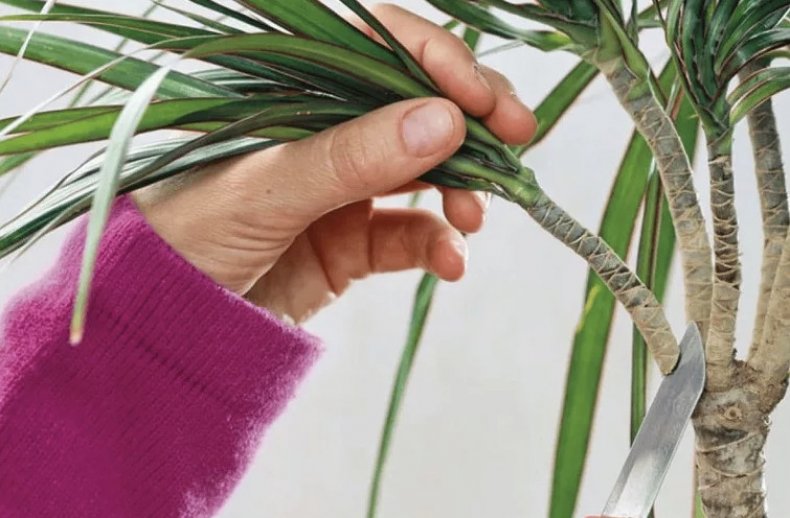
The water should be settled, you need to add it as needed. The place for layering should be warm and well-lit. After two months, the roots will appear, and the dracaena can be transplanted into a regular pot of soil.
The main thing in the reproduction of dracaena, whatever method you choose, is the subsequent proper care.
These are the basic rules on how to take care of the dracaena at home and provide it with the necessary conditions for full development. This plant, due to its beauty, can become the pride of any home.
Watering
The moment of finding a balance is important: the plant loves moisture, but dies when the water in the pot stagnates.
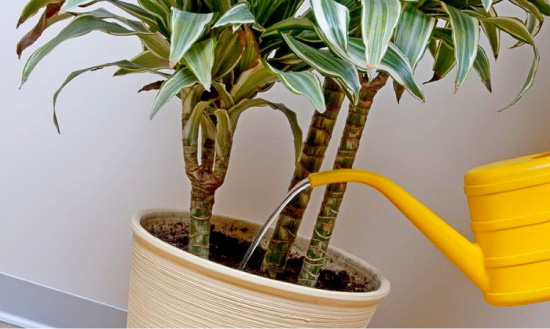
Average watering schedule:
- 2 times a week in summer;
- Once every 10-14 days - in winter.
The division into seasons is due to the fact that the dracaena has a dormant period during the cold season.
When watering, be guided not only by the given data, but also by the specific living conditions of your tree: if the soil is very dry, watering can be done more abundantly. And vice versa.
Life hack: if you are afraid of over-watering or have already poured the plant once, use bottom watering. The water poured into the pan will saturate the soil in the required amount.
Important: the water for irrigation must settle. Watering the plant with cold tap water can spoil the leaves by the appearance of white spots.
Home benefits and harms
- Dracaena is endowed with the following useful qualities:
- neutralizes the effect of chemicals;
- eases the sensation of temperature changes;
- helps to cleanse the body of toxins;
- removes painful sensations in muscles and bones;
- promotes wound healing;
- keeps teeth in good condition;
- helps to restore mental balance;
- promotes resistance to emotional states.
Important! Dracaena is indispensable in the office, as it is endowed with the ability to neutralize formaldehyde, which is often prevalent in rooms with office equipment.
- The only problem is the juice, which is low-toxic and, if ingested, can lead to similar problems:
- indigestion;
- diarrhea;
- shiver;
- weakness.
This is especially dangerous for babies and pets, who may accidentally eat the leaves.

Dracaena is not a palm tree
Probably one of the reasons for the popularity of Dracena was her unusual appearance.In the late 90s and early 2000s, there was a great demand for exotic, and Dracena was bought to grow at home. Moreover, the greatest demand was for very large specimens, which were used to decorate the interior.
In common parlance, this plant is called the Dragon tree or indoor indoor palm. But in fact, this plant has nothing to do with palms, but comes from the Agavaceae family. Most often, Dracaena Draco, Dracaena marginata, Dracaena fragrans and some other species of this plant are grown at home. They all differ in the shape and color of the leaves.
Dracaena with pointed, long, narrow leaves, which are connected in a slightly disheveled bunch, look especially impressive. These plants have a beautiful tree-like trunk. Sometimes Dracena is shaped like a bonsai.
The homeland of Dracen is the tropical rainforests of South America and Africa. These plants thrive in warm regions of Australia, New Zealand, India and Spain. And when you are going to grow Dracena, try first of all to create familiar conditions for her.
A combination of fertilization and irrigation
Since this plant is limited by a small amount of land, over time it completely draws out all the useful minerals from the soil, which makes it impoverished. In addition, watering also contributes to the leaching of elements, so the dracaena needs additional and regular feeding.
Most often, the plant is fed during watering with liquid mineral complex fertilizers. For dracaena, they work well, although for specimens with variegated leaves it is better to use fertilizer "for variegated plants".
We advise you to read what and how to feed indoor plants.
Such a top dressing is simply added to the water for irrigation in the dosage indicated on the package and poured over the dragon tree with a watering can through the top.
Dracaena should be fed only during the growing season, which begins in March and lasts until the end of summer. At this time, the frequency of feeding is once every 2 weeks. In winter, you do not need to feed the plant.
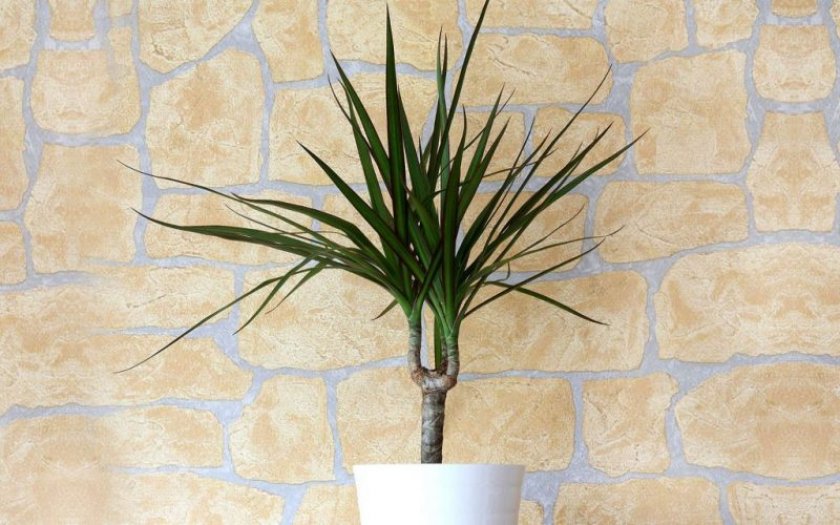
For fertilization, it is best to choose the evening time, since it is unacceptable to use fertilizers during the day, because the sun's rays can burn the plant. On cloudy days, you can apply top dressing early in the morning.
Dragon palm pests and control
Parasitic insects can also attack the house palm, causing serious damage to it. They suck nutritious juices from the plant, and in addition, many of them cause the development of secondary infections.
Thrips
If black dots appeared on the dracaena leaves, and around the plate became discolored and covered with a sticky coating, then most likely thrips chose it. Later, the foliage of the palm tree begins to bend and fall off.
The affected plant is isolated from other domestic flowers, damaged foliage is removed, and the dracaena itself is treated with insecticidal agents.
Spider mite
This small parasite settles on the back of the leaf blades and yellowish-brown small spots are the first signs of its appearance. And he also entangles the foliage with the thinnest cobweb, along which he "travels", moving to other parts of the palm tree.
To get rid of a flower from its "neighbors", it is necessary to wipe its leaves with a cotton swab soaked in a solution of laundry soap, removing pests as well. For these purposes, you can also use tar soap.
It is recommended to cover the palm tree covered with soapy foam with a paper bag and leave for several hours, up to a day. If the lesion is severe, then after removing the soap from the foliage with jets of warm water, it should be treated with an insecticide.
Spider mites are very contagious, so the affected palm is immediately removed away from other flowers. Plants standing nearby should be carefully examined.
Mealybug
Due to the fact that insects outwardly look like lumps of cotton wool or fluff, they were called shaggy lice.They are quite active and spread quickly, infecting other vegetation as well. Another parasite settles on their sugary secretions - a sooty fungus.
With a small lesion, it is enough to treat the palm leaves with a soapy solution, and then spray it with a solution of green soap or garlic tincture. It will take 2-3 procedures with a 1-1.5 week interval. If the insect colony has managed to seriously harm the dracaena, then you cannot do without the use of an insecticide. It can be sprayed with Aktara, Calypso, Confidor or Fitoferm. Sometimes you need to apply different means to find the most effective one.
